Your ultimate guide to B2B Growth Hacking!

Table of Contents
B2B Growth hacking isn’t magic; It’s a process and a mindset that drives B2B growth.
Growth hacking is not a one-size-fits-all strategy but it does provide a framework that companies such as Slack, Dropbox, Netflix, Airbnb, and Robinhood used to grow their active user base and retain them!
What’s in it for you?
In this article, I will explain what B2B growth hacking is, how you can get started straight away, proven B2B growth hacking strategies, 50+ growth hacking tools, and some examples of companies who implemented it successfully.
I will also provide you a B2B growth hacking framework, called the AARRR framework.
This is a lengthy post aimed to provide you with all the information you need to implement this at your company. Below is a table of contents to help you navigate this post.
- How to get Started with B2B Growth Hacking?
- How to become a growth hacker?
- B2B Growth Hacking and the Marketing Funnel
- Growth Hacking Strategies
- 51 of the best Growth hacking tools
- 10 Stellar growth hacking examples
- Conclusion
How to Get Started with B2B Growth Hacking?
Below are 6 steps that are pivotal to getting starting with B2B Growth Hacking.
Understanding the basics
B2B growth hacking can be overwhelming to people who are not familiar with the term. Perhaps you've just started your B2B marketing career. Earlier I said that growth hacking is a mindset and a process for growth marketing.
Breaking through in B2B markets is hard and it doesn’t happen by chance. Companies that broke through had a growth mindset and process which they followed.
Let’s start with the basics:
What is B2B Growth Hacking?
The definition of B2B growth hacking is a process of rapid experimentation across the marketing funnel to grow a business rapidly. Basically, it is an umbrella term for strategies that are only focused on growth. This tactic is mostly used at start-ups or new teams who aim at exponential growth in a short time period.
The goal of B2B growth hacking strategies is to acquire as many users or customers as possible on a small or limited budget. That is why this strategy is so popular among start-ups. New companies do not have infinitely deep pockets and they need to expand their business fast to stay alive.
In B2B markets is easy to follow strategies that have an average performance. However, in order to breakthrough in a market, you need to be doing something different.
Growth hacking focuses on rapid marketing experimentation. However, experimentation without a process is prone to failure. A well-defined process is pivotal to be successful in B2B growth hacking. A proven process is to follow a framework which brings me to my next point.
Selecting the right framework
While a massive part of marketing is user/customer acquisition, it should not be the sole focus. You need to under the entire buyer journey and implement growth hacks across the full buyer’s journey.
If you acquire many users but they churn fast then you are effectively fueling the marketing engine but your engine is not burning the fuel efficiently, a.k.a. waste.
A proven B2B growth hacking framework is the AARRR framework. This framework focuses on B2B Acquisition, Activation, Retention, Revenue, and Referrals.
Further down in this post, I will describe each step of this framework and explain how you can optimize that step for growth marketing.
Implementing the right digital marketing tools
In order to be successful at B2B growth hacking, you need more than just a great team. In order to create scalability, conducting research, and accelerating the marketing funnel, you need to have the right digital marketing tools.
Tools are generally quite expensive and especially as a start-up up it might be hard to come up with the budget. Some tools such as Ahrefs are considered to be the golden hammer when it comes to growth hacking tools. However, Ahrefs is mostly focused on user acquisition and to drive traffic to your website.
While this is extremely important, you also need to focus on other aspects of the marketing funnel such as user onboarding and referral marketing.
Further down in this post, I’ve compiled 50+ of the top growth hacking tools. This should provide you a comprehensive list to get started.
I’ve mentioned that it is important to focus on the full buyer journey. That’s why I’ve categorized those 50+ tools in stages according to the AARRR framework. E.g. 10 tools for acquisition, 10 for activation et cetera.
Get internal buy-in from management
B2B growth hacking is a process of rapid marketing experimentation. With experimentation comes failures. Some of your budgets will go to activities that won’t be performing at all!
Your goal should be to carefully analyze your campaigns. When you’ve found the golden nugget – the campaign that works well for you, then take that campaign and optimize it.
However, you will also have to do a lot of reporting on campaigns that might not work so well. Therefore, before you get started with B2B growth hacking, you need to get the buy-in from management.
They need to understand what your growth marketing team is trying to achieve. Only with their full support can you conduct marketing experiments at full efficiency.
Optimize your internal infrastructure to capture data
As mentioned in point 4, you need to find the golden nuggets. However, this is extremely hard to do without the right infrastructure.
Before you start your campaigns, you first need to sit down and figure out exactly what you’d like to measure. When is a campaign considered to be a golden nugget?
However, your marketing infrastructure should not just be focused on campaigns. On a corporate level, you need to define the criteria for when a lead turns into a Marketing Qualified Lead (MQL).
Also, when are they a Sales Qualified Lead. Some more food for thought is to think about marketing attribution. How will opportunity values to attributed to a campaign? Will you use a first-touch attribution model, or perhaps a last-touch. Maybe you prefer the W-shaped model.
This should be at the core of your operations because without proper infrastructure, you will be driving blind.
Become data-driven
Once you have figured out the right infrastructure, it is now time to put that data to use.
When growth hacking for B2B markets, you need to understand that sales cycles are generally quite long. Take this into consideration when looking at data.
One of the things that you might be looking at are campaigns to reduce the time for a sales cycle to complete.
The bottom line, if you are going to implement growth marketing and doing rapid marketing experimentations, you need to be able to rely on data. You need to fail fast, and that is only possible when you are obsessed with data.
Don’t just look at the data, but really try to understand the meaning behind that data.
How to Become a Growth Hacker?
A successful growth hacker is always thinking about strategies to grow. Growth hacking is a mindset. This can partially be trained, but this mindset should really be ingrained in the DNA of a growth hacker.
As Sean Ellis said: “A growth hacker is a person whose true north is growth”. Perhaps your true north is not growth yet, but at the end of this post, you’ll have a lot of ammunition to change course and start implementing demand generation strategies for your business.
A growth hacker is focused on rapid experimentation and should be comfortable with failing. You will always be focused on finding new strategies for demand generation and executing ideas.
Remember that every company is different, especially in the B2B marketplace. There are so many different buyer personas, so strategies that worked at Company A, might not work at Company B.
A growth hacker and in my opinion, any marketer, should be data-driven. You can only determine the success of a growth hacking strategy by analyzing the data. If you are not focused on data, you are driving blind. And that is not a good idea.
The reality is that growth hackers are using many different channels at the same time to realize growth. This is also called an omnichannel strategy. If you don’t have measures implemented to track the performance of your campaigns, you will have no idea which campaign is working or not.
So if you want to become a growth hacker, you need to start focusing on B2B demand generation techniques backed by data and not be afraid to fail. In addition, you will need a growth hacking framework that works in B2B markets. Later in this post, I will explain the AARRR framework.
B2B Growth Hacking and the Marketing Funnel
As I’ve mentioned, growth hacking is really a mindset focused on rapid marketing growth across the marketing funnel.
To succeed in growth hacking, you can’t only be focused on customer acquisition. You also need to focus on retention, activation, increasing customer lifetime value and creating word-of-mouth advertisements.
Often in marketing funnels, people talk about the top of the funnel (ToFu), middle of the funnel (MoFu) and bottom of the funnel (BoFu) activities. In order to convert leads into customers, you need to have a well-oiled marketing machine.
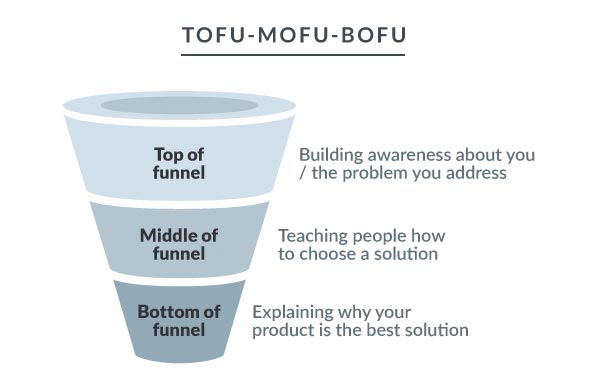
You can create millions of leads, but if the MoFu and BoFu aren’t optimized, you will be wasting a lot of leads and money invested in acquiring those leads.
In other words, your growth marketing engine must be working effectively across the entire marketing funnel. If you add too much fuel at the top of the funnel, and the marketing engine can’t burn the fuel efficiently, then you will be wasting fuel.
At many B2B organizations, leads that are at the BoFu are often handled by the sales organization. However, marketing can still help sales by influencing BoFu leads by providing certain content or having a proper onboarding experience.
Therefore, B2B demand generation in marketing should always focus on ToFu, MoFu, and BoFu. This brings me to a framework that focuses on the entire marketing funnel.
Which growth hacking framework should you follow?
AARRR, Matey! The growth hacking framework that you should follow is the AARRR framework which focuses on Acquisition, Activation, Retention, Revenue, and Referral. These 5 metrics represent all the behaviors of our (prospective) customers.
This framework was developed by Dave McClure and it has helped numerous companies such as Autopilot and Piktochart achieve exponential marketing and business growth. It is so successful because it forces companies to look at the entire buyer journey. By understanding the buyer journey, you can optimize each and every process to maximize impact.
The AARRR framework has been around for a while as it was created in 1992. Until this date, it is considered one of the best business frameworks out there.
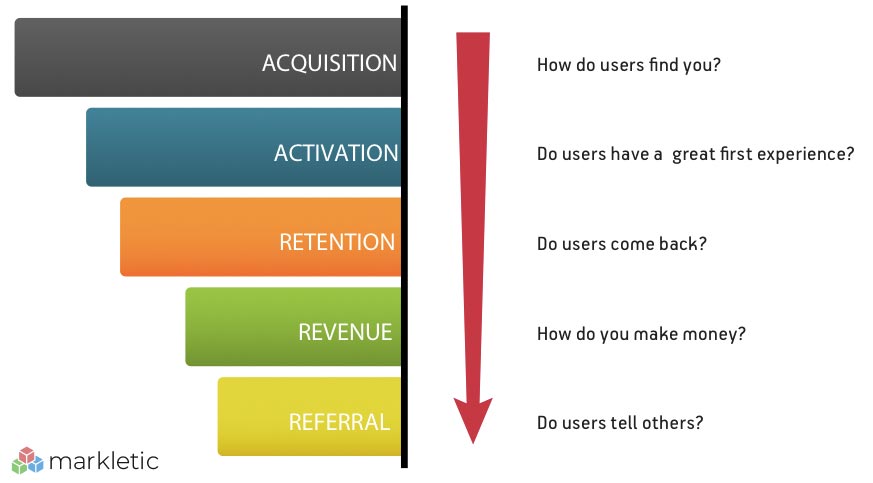
With B2B demand generation, it is critical to not only focus on the customer acquisition side of things. If you neglect the other 4 steps, then you might have a lot of new customers, but your churn rate will also be high and you’ll effectively be wasting money. The lifetime value of satisfied customers is not something to be overlooked.
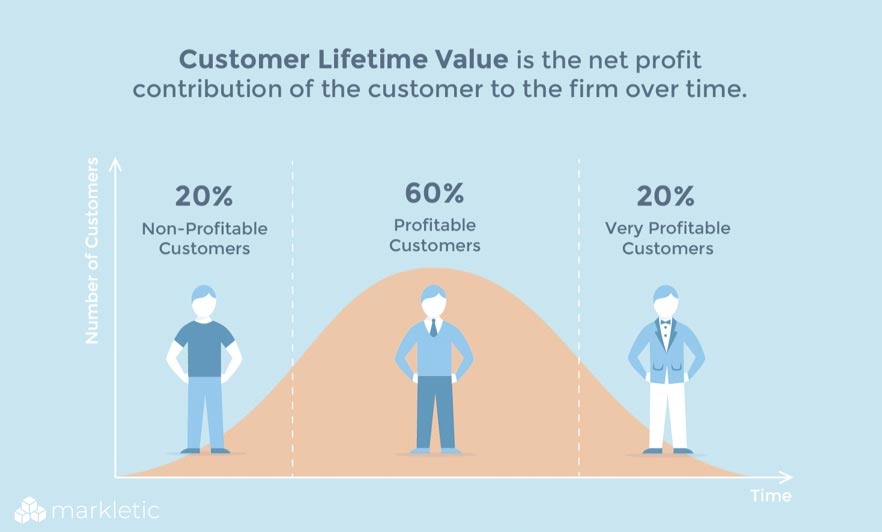
Let’s dive into each step of the AARRR framework individually to provide you with more context.
Again, B2B growth hacking is about having the right mindset and process. Implement this process and you’ll be driving significant B2B growth.
AARRR Phase 1: B2B Customer Acquisition
Customer acquisition answers the question of how to get visitors to your website and from which sources.
First off, you want to make a situational analysis to determine your current top traffic sources. You can easily do this by diving into Google Analytics and checking your acquisition channels.
If you are a start-up, you probably don’t have loads of visitors coming to your website. As a B2B growth hacker, you are looking for exponential marketing growth. But how can you achieve this?
There are a few strategies you can follow when it comes down to rapid marketing growth at the acquisition stage.
- Viral B2B growth
- Sticky B2B growth
- Paid B2B growth
What is viral B2B growth?
Viral marketing is a business strategy in customer acquisition that uses the internet and social media to promote a product or service to the masses. The focus is on the way consumers spread information and it works much in the same way that a virus spreads from one person to another. It is most often achieved through extreme social media exposure and word-of-mouth.
Viral marketing is often achieved by evoking emotions in people. When people are emotional about a marketing campaign, they will start talking about it and sharing it on social media. So what emotions can trigger a viral marketing campaign?
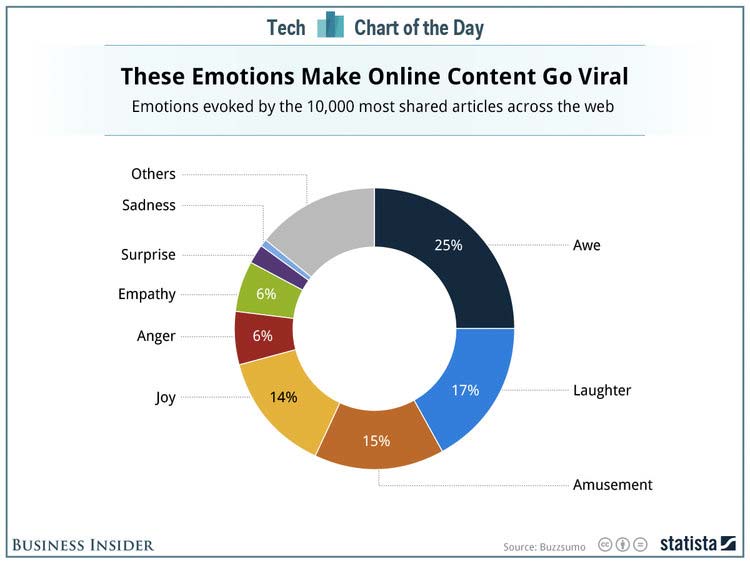
Probably everyone remembers the ALS ice bucket challenge. This was a campaign that went viral and not just in America but across the globe. The ALS ice bucket challenge started in 2014 and it was an online effort to raise money for people with Amyotrophic Lateral Sclerosis (ALS) disease.
The campaign was a huge success and they were able to raise $115 million dollars in a span of 8 weeks! This is partly due to the fact that celebrities across the globe were participating in the challenge as well. Celebrities have a huge impact on the masses and that’s why it achieved so much growth.
Another contributing factor was that after completing the challenge, you had to nominate three other people on social media to do the challenge as well. Using the example of Bill Gates, he was challenged by Mark Zuckerberg. This is a perfect example of viral marketing.
In reality, it is hard to think of a campaign that can go viral, especially in B2B markets. The most important thing is to evoke emotion, get other people to contribute and provide value.
What is sticky B2B growth?
Sticky marketing is the art of getting people to use your platform or product for a long time. Sticky marketing is also known as engagement marketing. The goal is to make sure users interact with your content as soon as they first see it. By having a high level of engagement, users are likely to recommend your product or service to other people. Consider B2B Content Binging.
Achieving engagement comes down to building trust and being personable. When trust is built through relationship-based marketing, people will stick and spend more time and money with you rather than on your competition.
The king of sticky marketing is Facebook. They’ve mastered the ability to keep people to use their platforms by providing value and their ability to connect people.
It is important to reduce customer churn.
Customer churn is when an existing customer stops doing business or ends the relationship with your company.
How do you reduce your customer churn?
By having a guided success path and going the extra mile from the start. You have to really care about your customers and making them successful with your product. Satisfied customers will never leave you. Unsatisfied customers will drop you at the first chance they get. If it is a large customer, make sure to have a customer success manager in place.
What is paid B2B growth?
Essentially any expense on marketing can be categorized as paid marketing growth. However, not every company has exciting products that can leverage viral and sticky marketing growth.
Viral and sticky marketing most often applies to SaaS companies but let’s say you are in another industry that doesn’t benefit from online growth. What are your options when you are responsible to market an over-the-shelf product?
The answer often lies in commercials and sponsorships. A great example is Red Bull. Any time you see a video of an extreme sport, it is a matter of time before you see the Red Bull logo. This doesn’t come for free and Red Bull is spending a lot of money sponsoring athletes and extreme sports events.
Is it worth it? Red Bull has sold over 68 billion cans since the company was founded. So, you tell me.
When it comes to paying for user acquisition, it is important to keep in mind the customer lifetime value.
Let’s say you sell a product that costs $10 monthly and you retain that customer for 2 years, it means the customer lifetime value is $240. If you paid $50 to acquire that user, the value is still tremendous.
Paying for customer acquisition is a great growth hacking strategy but it can sometimes be hard to measure. You have to manage expectations with management and think about long-term value.
AARRR Phase 2: B2B Customer Activation
You’ve spent a lot of time and money on customer acquisition, now it is time to activate those customers. Customer activation is the process of making users understand your product.
This step is extremely important because it has an influence on all of the later stages (Retention, Revenue, and Referral. This is also the step where you have the possibility to make your customers fall in love with your product.
So how can you activate new users or customers?
Many companies already have an onboarding experience through an email nurture campaign. Usually, the first email is a welcome email with some tips and tricks to get started.
As the welcome email nurture advances, the tips and tricks are getting more in-depth. Your sole aim should be to provide value. The last thing you want to do is come across as a spammer. You should consider B2B content binging to convert leads faster and reduce the average cost per MQL.
Another method is in-platform onboarding through a guided onboarding experience. Further down this post, I’ve listed some of the best growth hacking tools for customer activation such as Userlane.
With in-platform user onboarding, you basically hold the hands of your users and guide them through all the major features that your platform or product offers. Implementing a guided success path for your new customers will help you to reduce customer churn which results in more revenue while taking into consideration the customer lifetime value.
Often times, new customers use your product at entry levels. By first landing customers and then expanding them, you will create more value for your company. It is easier to get revenue from existing customers than from new customers.
A great growth hacking technique is to do the onboarding through gamification. With every step completed, the user can score points and if they reach a certain threshold, you can give them something for free.
I also recommend having a documentation hub on your website that is filled with video tutorials. Video tutorials allow you to teach your users how to use your product by example. This has a much larger impact than only providing written documentation.
Take for example Elementor, a page builder for WordPress. On their YouTube channel, they have an entire playlist about getting started with their platform.
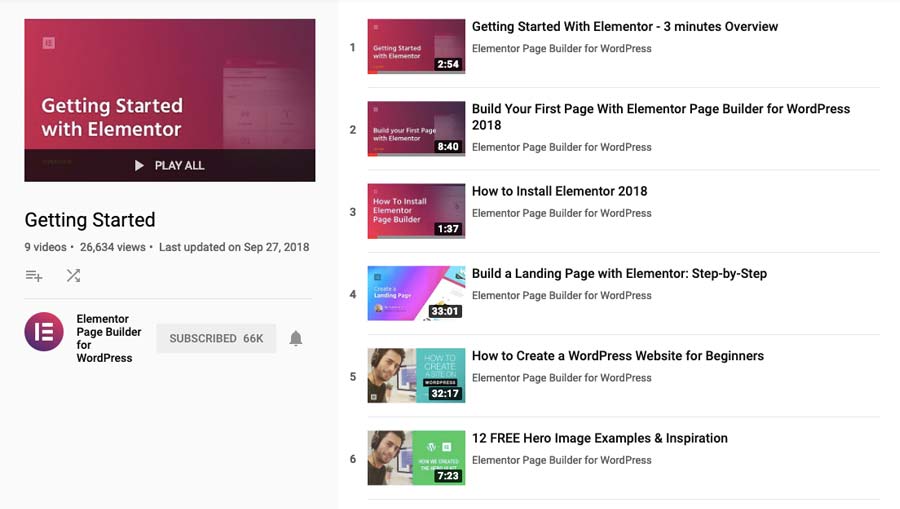
If you are responsible for growth hacking an enterprise product, you can even provide training courses. I’ve seen SaaS companies provide free and paid training courses where people have to obtain various certification levels such as beginner, intermediate and advanced.
By the way, the SaaS definition is Software as a Service. This means that the company sells software. Are you a SaaS marketer? Here is how to achieve insane SaaS growth.
LinkedIn also has a great onboarding experience. LinkedIn provides you with a guided success path to complete your profile. By having a so-called all-star profile, more people will find you in through their search functions and this could help you get noticed by recruiters.

When users have more time invested in your product or platform, they will be more emotionally attached and spend more time using your product.
AARRR Phase 3: B2B Customer Retention
Customer retention answers the question of why your users are coming back to your product or platform. Or perhaps, why they are not returning.
With customer retention, your goal should be to retain as many users as possible. As mentioned before, it is much easier to upgrade an existing customer to a higher subscription package than landing a new customer.
How to check user retention in Google Analytics?
There are a few ways to analyze your user retention in Google Analytics. You can look at the percentage of new users that are have visited your website.
Users - new users = returning users
But my favorite feature is using the Google Analytics Cohort Analysis. This is probably one of the most powerful reports in Google Analytics and is often overlooked.
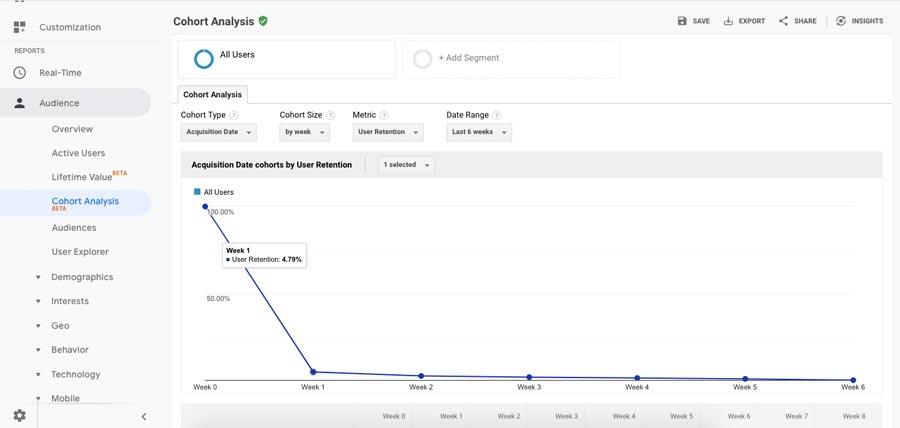
Let’s start by explaining what a cohort is.
A cohort is a group of users who have a shared set of characteristics.
There are a few settings that you should understand.
Cohort Type: This one is simple as the only option is “Acquisition date”.
Cohort size: The size of your cohort. Do you wish to divide your cohorts into days, weeks, or months?
Metric: Here you can input the metric that you want to analyze. In this case, we are looking to measure user retention so let’s select that. It can also be revenue, session duration or really any other metric that you want to analyze.
Date Range: The date range is the time period of the cohorts you want to review. This can be days, weeks or months, but it depends on the cohort size you’ve chosen.
Ideally, you want your line chart to look something like a hockey stick. In reality, this is quite hard and will probably more like a flat line. Let’s look at the data.
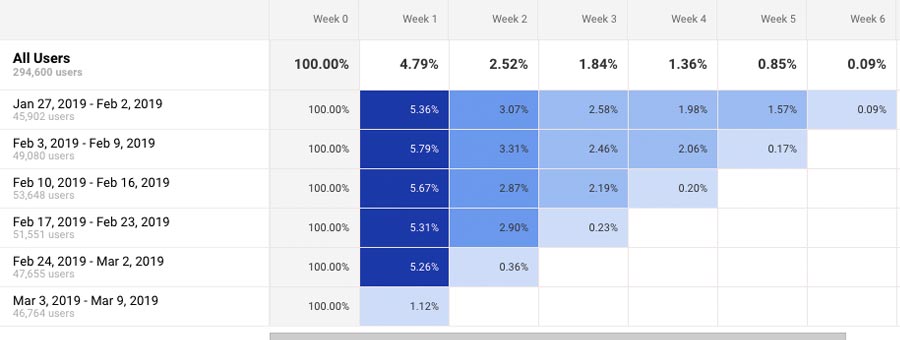
The above data can be a bit overwhelming at first but I’m here to simplify it for you.
According to the data above 5.36% of the users that I acquired between January 27 and 2 came back to my website the next week. 3.07% of those same users even came back 2 weeks after first acquiring them.
The higher the numbers, the better your user retention. The beauty of this cohort analysis is that it lets you dive into the details and aren’t just vanity metrics.
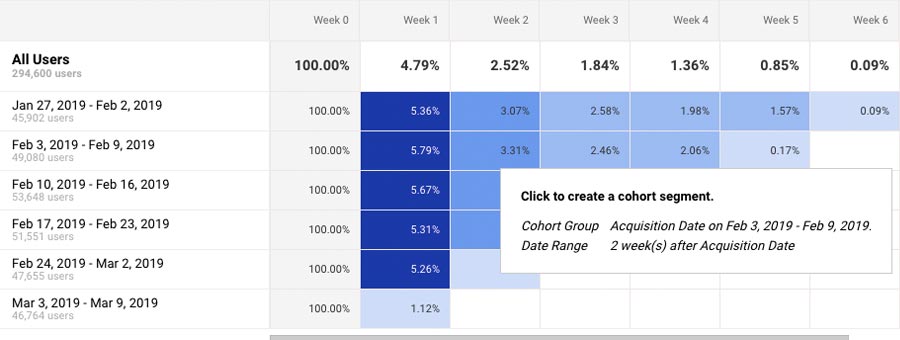
By clicking on a cohort, you can create a segment. You can then use that segment to view any other report in Google Analytics such as acquisition source, locations, and conversions.
Let’s say that you notice that you are retaining more users in week 1 compared to week 2. You can analyze this by checking where your users came from. Perhaps certain acquisition channels provide better user retention.
When you are responsible for demand generation for your company, you want to analyze which channels give you the best results. At the end of the day, people who return to your website will be your champions and they are more likely to recommend your website or product to other people.
With growth hacking, you can’t just look at only acquiring new users. You also need to look at retaining users and creating happy customers. Word-of-mouth advertising is the best advertising. New users are great. But, a lot of happy users or customers are 10x more valuable.
When users are coming back to your platform, it means they think your product or content is great. That should your goal.
If you are looking for some books on this, check out Lean Analytics: Use Data to Build a Better Startup Faster. This is a truly valuable book that helped me a lot with analytics.
AARRR Phase 4: B2B Revenue
We’ve focused on customer acquisition, customer activation, and customer retention. Many marketers can’t agree on whether revenue comes before the referral stage in the AARRR framework. In reality, it will be a mix. In some cases, people will refer your product without purchasing, and in other cases, they will only refer after purchasing.
This is dependant on many factors. Maybe you offer a freemium version of your product. They loved it so much and are now referring it to others. Freemium marketing is a great SaaS growth hack.
Maybe your blog is awesome and before trying your product, they are referring back to your blog.
In most cases, people will refer to you once they’ve actually tried your product and are a happy customer. That’s why I’ve marked referrals as the last step and we will now focus on revenue.
What good are loads of users on your website when no-one is converting into a customer?
Creating revenue is undoubtedly one of the most important factors in B2B demand generation. At the end of the day, when you are reporting on your growth hacking initiatives, you are going to have to report on ROI. Without conversions, good luck with the conversation with your manager.
So, the revenue phase is all about making sure that what you do online and sometimes offline turns into an income stream.
Let’s say you are working for a SaaS company, there are multiple ways for you to generate an income stream.
The best way to convert people is to give them a little taste of what your product has to offer. Therefore, most SaaS companies offer a freemium version of their software. So what options do you have?
A freemium plan: This is all about offering a free version of your product. Often times companies limit some features in the free version. I don’t recommend doing this, because people don’t experience the full power of your software. Instead, offer a limited trial period that opens all the doors to your product. Again this SaaS growth hack works wonders if implemented properly.
Affiliate marketing: By allowing others to promote their services on your blog, you can generate an income stream at the early stages of your start-up. This helps to fuel the rocket before taking off.
Paid plans: This should be part of any SaaS pricing model. Offer a scalable pricing model that is transparent.
How do you check if the pricing model is right for your business?
The best way to check if your pricing model is right, especially when you are starting, is to test various models. Just like any other aspect of marketing, you need to A/B test your pricing page.
The best tip I can give is to be transparent. No-one likes to visit a pricing page and not being able to make a proper cost prediction. You should be able to provide an overview of all the pricing options and the benefits of each plan. A great example is the pricing page of Dropbox.
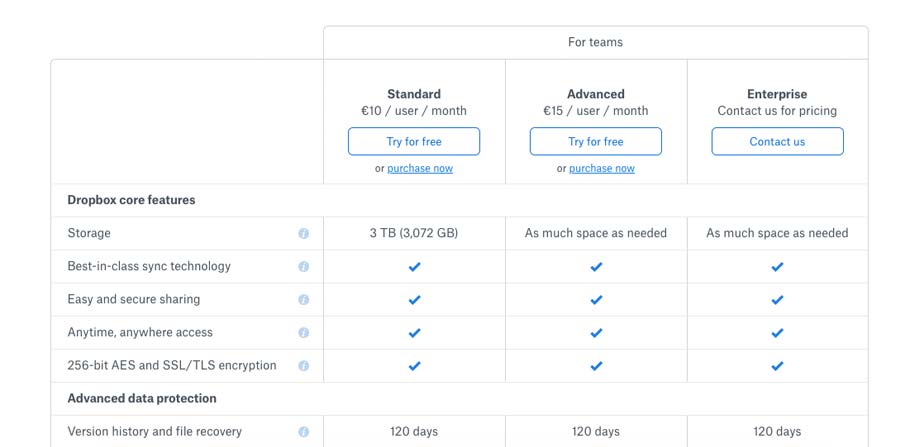
Why is this a great pricing model? Because the pricing model is transparent, it has a feature comparison chart, it has an option to try for free, and there is a button to talk to sales for bigger customer needs.
AARRR Phase 5: Referral
You’ve acquired customers, activated them, and they’ve bought your product. Now what?
The last step of the AARRR framework is referrals. The goal here is to get people to recommend your product to others.
As I’ve mentioned before, satisfied customers are most likely to recommend your product. However, this is not always easy to achieve.
Many SaaS companies have a customer ambassador program. The goal here is to talk to your most active and satisfied customers and get them to recommend your product.
Generally, when your sales team is trying to close a big deal, the sales cycle will take many months. Brand ambassadors can help shorten the sales cycle by doing reference calls with your prospective customers. This is especially useful when the brand ambassador is in the same industry as your prospective customer.
Keep in mind that the brand ambassadors should also get something in return. The relationship won’t work if all you are doing is using them. Whenever you create an ambassador program, think of something that you can offer them. Taking Dropbox as an example, you could offer ambassadors more storage with every reference call they complete.
Word-of-mouth advertising is the best advertising you can get, I’ve said it many times. The referral stage is a critical phase of growth hacking and demand generation. But how do you measure if your customers are satisfied at all?
The answer is by measuring the Net Promoter Score (NPS). The Net Promoter Score is a tool to measure the loyalty of your customers.

With the NPS, you ask your customers on a scale of 0-10 how likely they are to recommend your product or service to others. Based on their response, they fall into one of the three categories: Detractor, Passive, and Promoter.
Detractor
Detractors are the people who gave a score lower than or equal to 6. They are not thrilled about your product and therefore they won’t recommend your product to others. When they score at the lower end of the spectrum, they could be harmful to your company through bad word-of-mouth. As word-of-mouth is one of the biggest accelerators in growth hacking, you want to avoid this.
Passive
Passives are the people who score either a 7 or and 8. They are somewhat satisfied but could easily switch to a competitor if they have the opportunity. If you give these people extra attention, you can easily convert them into promoters. They might promote your product, but only when asked about it. They won’t proactively promote your product or service.
Promoter
Promoters are your gems and as a growth hacker, you should be really interested in collecting as many gems as possible. Promoters are the people who are extremely satisfied with your product or service. These are the people that will proactively recommend your product or service to others. You must provide these people with as many tools are possible to actively promote your product. These are also the people that will be great for your ambassador program.
How do I calculate NPS?
You can calculate the NPS by subtracting the percentage of customers who are detractors from the percentage of customers who are promoters.
% promoters - % detractors = Net Promoter Score
This will generate an NPS between -100 and 100. Naturally, you want to aim for 100, which means you would have the highest NPS possible.
Simply ask your customers this question:
From a scale from 0 - 10, how likely are you to recommend [brand name] to others?
If you’re looking to compare your NPS to your competitors, I recommend taking a look at NPS Benchmarks.
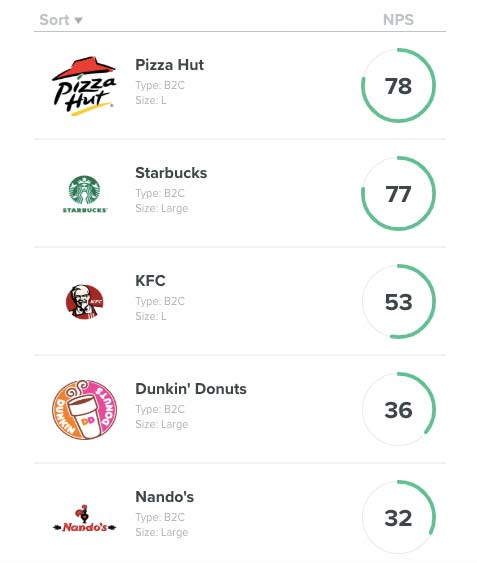
B2B Growth Hacking Strategies
There are not set in stone B2B growth hacking strategies that will guarantee the exponential growth that you are after. Growth Hacking is all about experimenting and it will always require an omnichannel approach.
Each business is different, and you will have to experiment to find the golden combination of strategies that will launch your company into space.
This doesn’t mean that there aren’t a bunch of strategies that will always help with growing traffic and your customer base.
The majority of growth hacking strategies fall under four buckets:
- Advertising;
- Content marketing;
- Product marketing;
- Community;
Let’s dive into each bucket separately.
1. Advertising
As a growth hacker, you are probably working at a start-up without a huge marketing budget. Advertising done wrong can quickly cost you thousands of dollars if you are not paying attention. So what exactly can go wrong?
- Not advertising on the right platforms;
- Not defining your audience properly;
- Not targeting the right countries;
- Not optimizing your bidding strategy;
- Not A/B testing your ads;
- Not monitoring your advertising campaigns.
These are just a few examples, but I could go on and on. The conclusion is that you need to be doing rapid experimentation and making sure you fail fast. But let’s focus on the positives and on driving B2B growth.
Especially as a start-up, the majority of your website traffic is probably coming from advertisements. People see hundreds of brands on a daily basis: when we watch TV, browse the internet, social media and when we walk through the streets.
Before people start recognizing your brand, you need to get in front of those people at least 10 times. Meaning they have to see your brand name 10 times before they start remembering your brand name.
This means that remarketing is extremely important to become and stay top-of-mind. You are spending so much money and effort on getting new people to your website, and it would be a waste to let them go afterward.
Install a Facebook Pixel on your website and start remarketing people on Facebook, as an example. It is much easier to get people to return to your website after they have been there for the first time.
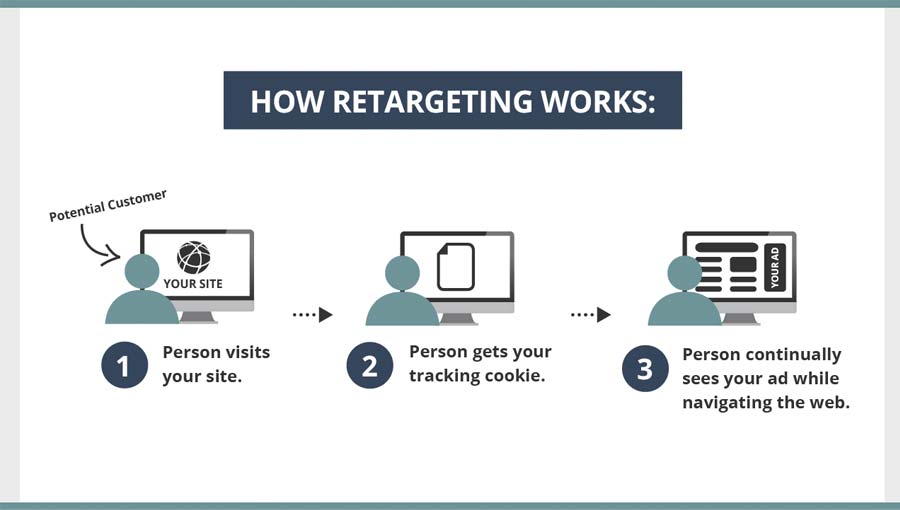
If you are a tech company, consider advertising on Reddit. If your target audience is young people, consider advertising on 9gag. If you are a B2B company, consider advertising on LinkedIn. The point here is that you have to identify your target audience and then look at which platforms they are using.
Remember, growth hacking is about rapid experimentation. If you notice that a certain channel is working, invest more money into it. If you are not getting the desired results, terminate and move on.
2. Content Marketing
Advertising is nice, but if you don’t have fresh content on your website, people will stop looking at your website. Content marketing is the backbone for growth hacking.
If you want to stand out from the crowd, you need to be providing value to your prospects. There are millions of websites pumping out content on a daily basis. The best tip I can give you is to be personable. Think about it, there are billions of people on this planet, but we only connect with a bunch of them. Why? Because people have certain traits that you connect with.
When creating blog content, be personable and try to make a connecting with your readers. Stop being so corporate.
Depending on the tactics used, content marketing can be a low-cost initiative to propel your website into space. Content marketing is a long-term strategy and you might not see results straight away.
Here are some tips for content marketing:
- Write blog posts and create valuable, personable and shareable content;
- Create a podcast;
- Start doing video marketing;
- Use Medium to drive traffic to your website;
- Live-stream on social media;
- Run (on-demand) webinars;
- Get listed on relevant marketplaces such as Product hunt;
- Guest blogging;
- Try to get featured at major publications;
- Submit content to Help a Reporter Out (HARO);
- Run contest and giveaways;
- Get bloggers to review your product;
- Influencer Marketing;
- Write white papers and eBooks;
- Join relevant subReddits.
3. Product Marketing
Make sure to create a product that people actually want to use. This sounds so obvious, but with so much competition in today’s market, you are not getting away with mediocre products anymore.
Bad news always spreads faster than good news. Similarly, if you have a bad product, trust me, people will talk about it and the world will know.
Focus on having an outstanding product and once you have that, you can start with product marketing.
If we have learned one thing from cryptocurrency bull run in 2017, it is that people have the fear of missing out (FOMO). Leverage this successfully and you will see exponential growth. An example is a time-based sign-up promotion or limited-time discounts.
While you are at it, make sure that the user experience is stellar. Try to gamify the sign-up process and make it a unique experience. But don’t stop there, signing people up to use your product is one thing. Another one is customer retention.
A great way to retain users is to create challenges for them and really gamify the experience.
Waze does a great job at it. While driving around you are able to collect things.

You can’t do scalable growth hacking by yourself. You only have a limited amount of time per day to hack your way to the top. To become scalable, you can create a referral program, otherwise known as affiliate marketing. Offer people a bit of money for successfully referring other people to use your product. This is a great incentive for people to start writing content about your product. This will increase the number of backlinks to your website and improve your domain authority. Growth hacking is all about exponential strategies; this is one of them.
Always provide a free version of your product for people to test the waters. If the barrier to entering is too high, there are 10 other companies that will have lower entry barriers.
4. Community
The best advertisement is word of mouth (yes, I’m back at it), but how do you get people to talk about your product? Surely, you can have a good product, but you need more.
People start recommending you when you can give them a feeling that they are part of a community. At my office, there is a joke going around. How do you know if someone does CrossFit? Because they will tell you do they CrossFit.
People who do CrossFit talk about it so much because they are part of a community and they are proud of it.
This feeling and experience is something that you need to replicate. Another example is Starbucks. Starbucks is just another coffee shop, but they are phenomenal at one thing: making people feel they are part of a community. They perfected creating an experience and evoke emotion.
Let’s talk about another company that mastered the art of building a community.
“People of Tomorrow” Does this sound familiar? If so, you’ve probably attended Tomorrowland, one of the most famous music festivals on this planet.
Tomorrowland perfected community building and providing an out of this world experience when you attend the festival. When you visit Tomorrowland, it is such a fascinating sensation. You feel free, and out of this world. I live in the Netherlands and I’ve been fortunate enough to attend the festival, and I can tell you first hand that I will be recommending Tomorrowland to anyone. This is what you also need to achieve for your company.

Tomorrowland posted this picture on their social media platforms as a response to the recent 10-year challenge. They wouldn’t have been able to reach exponential growth without the community builder growth hacking technique.
The bottom line, create a community and provide them with a unique experience or sensation. Your product needs to be excellent, the user experience must be phenomenal.
51 of the Best Growth Hacking Tools
Growing your business at lightning speed requires having the right tools. Do a quick Google search and you will probably find hundreds of tools. Which are the ones that are good and useful?
As described earlier in this post, the Growth Hacking framework consists of the following 5 stages, click on any of the quick navigation links below to jump to the tools per stage.
In the end, you’ll be able to add some new tools to your list and experiment with them.
Growth Hacking Acquisition Tools
1. MailChimp
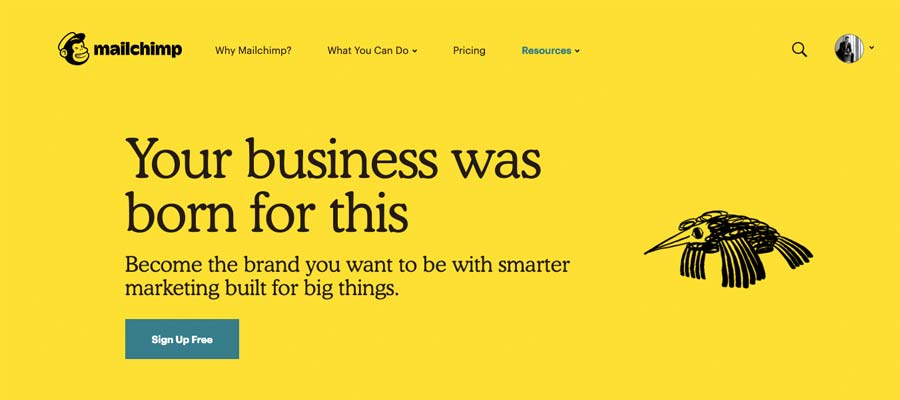
MailChimp is a marketing automation tool with a great focus on email marketing. With MailChimp, you can create automated email campaigns and drip nurtures. The great thing about the tool is the pricing model. It is completely free if you have less than 2000 subscribers! This gives you the ability to notify your first 2000 subscribers about new posts for free. Who doesn’t love that?
The tool allows for A/B testing and it integrates with CRM such as Salesforce. MailChimp also has an email design tool and loads of email templates available! You don’t need to understand HTML and CSS to design beautiful emails and you can start impressing your audience straight away.
Especially for start-ups, MailChimp is a great growth hacking tool due to the low barrier to enter and its ease of use.
2. Convertkit
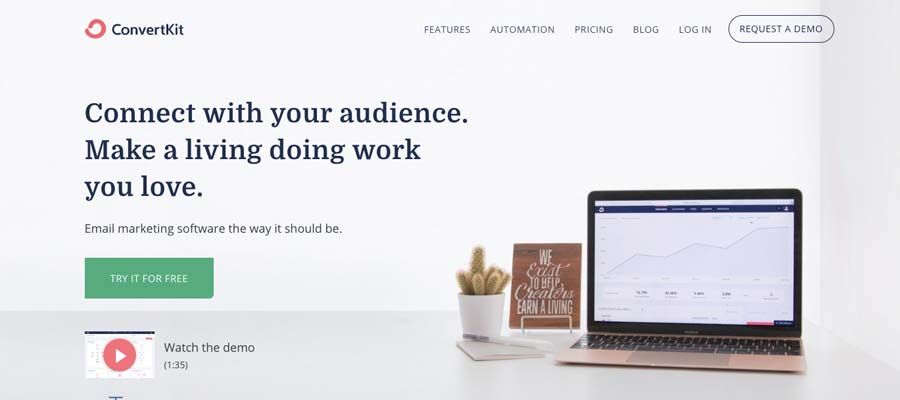
Convertkit is email marketing software and helps to build your email list. Again, for growth hacking, building an email list is incredibly valuable and I recommend everyone to do so.
Convertkit comes with the ability to create workflows. Based on segments and other criteria, you can send different emails to people. I can’t stress enough the importance of creating a personalized experience. There is a fine line between marketing automation and personalization. Convertkit integrates with WordPress and other tools perfectly and it very easy to use.
As a growth hacker, you want to spend as little time as possible to set up tools. You need to be focused on marketing experimentation and tools like this, with visual workflows will help you in your pursuit to walk on the moon.
3. OptinMonster
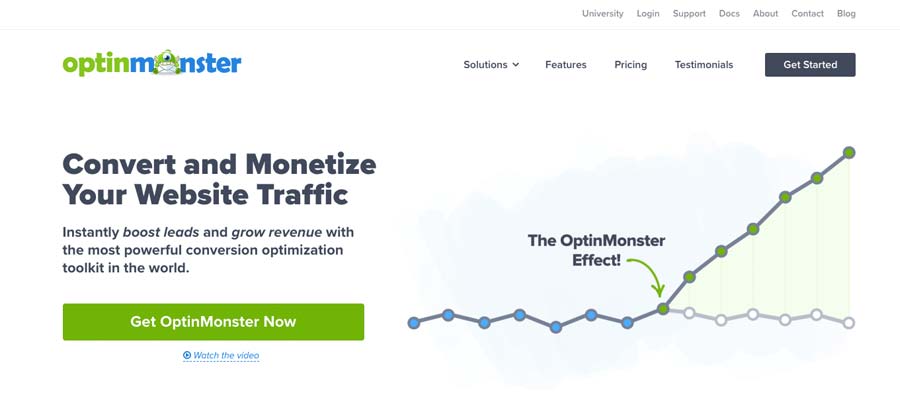
Having email marketing software is mission critical, but it is worthless without an email subscriber list. This is where OptinMonster comes into play.
OptinMonster is all about marketing conversion. Getting people to your website is one thing, another thing is converting them into leads and eventually sales.
With OptinMonster you can create pop-ups that capture the attention of your readers. With Exit-Intent technology, people can receive a pop-up before they leave your website. Your options here are limitless. You can ask them to subscribe to your blog; You can redirect them to another relevant blog post, or you can show them an offer.
The great thing about OptinMonster is their A/B testing functionality. With growth hacking, you always want to know about the layouts and designs that convert best. In addition, the tool also provides options for targeting. Let’s say you only want to target people from the United States with your pop-up. Or perhaps show different content to Europeans. It’s possible with OptinMonster.
4. ManyChat
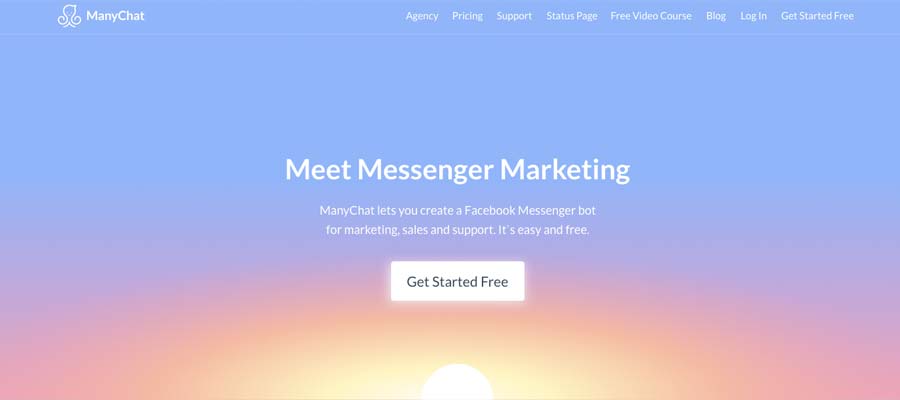
Whilst email marketing is still immensely popular and successful, you should also think about diversification. Billions of people are using Facebook and there is a huge untapped potential there for most businesses.
ManyChat lets you create a Facebook Messenger bot and it is free to use! In the future, we will see a rise of chatbot marketing for most companies. However, as a growth hacker, you should already be including this in your toolset.
The great thing about ManyChat is that you don’t need to know how to code. They provide a visual design interface in which you’ll be able to create your bot at lightning speed.
Think about it, when you have a new blog post or an offer, you can also notify your audience about it through Facebook Messenger. Usually, the open rates are much higher too!
When launching new content, the first hours are most important if you want to have any chance of going viral. As discussed, going viral allows for massive demand generation. Therefore, it is very important to reach your audience as soon as possible and get them to share your content within the first few hours of the launch.
5. MobileMonkey
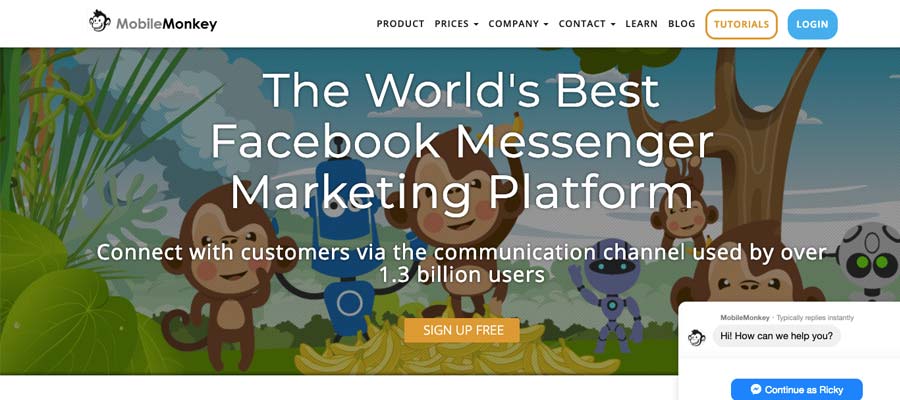
MobileMonkey is an alternative Facebook Messenger marketing tool. A great benefit is the ability to integrate with Facebook Ads. I’ve mentioned it before, but to be successful at growth hacking you need an omnichannel strategy.
With MobileMonkey you can blast new content to your audience through Messenger which will greatly improve your engagement. You can also let the tool answer frequently asked questions, let it create appointments and track purchases.
Your chatbot will take care of most of the conversations, but the tool also provides an ability to take over the chat so you can talk to your prospect directly. Especially start-ups are mostly budget conscious and therefore don’t have thousands of customer service employees. Chatbots are a really cool way to create a personable customer experience without spending too much money.
If you want to growth hack your way to Mars, include chatbots.
6. Ahrefs
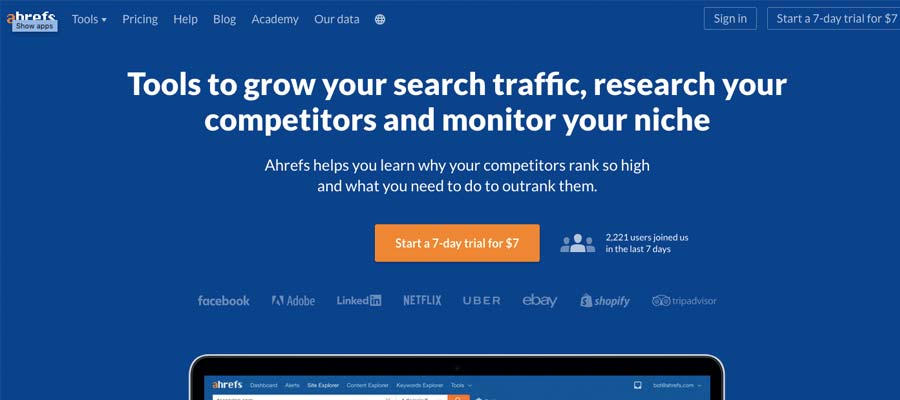
This tool deserves a blog post on its own as it can be considered to be the golden hammer for growth hacking. Let’s face it, most companies don’t have millions to spend on advertisements, so what is the alternative?
Organic search.
The aim of any growth hacker should be to get as much organic traffic to your website as possible. Ahrefs provides a whole heap of tools to grow your search traffic, research your competitors and monitor your niche.
Ahrefs allows you to do keyword research and backlink research. If you have a new company, it should be a priority to gain backlinks to your website. By using Ahrefs you can analyze which websites are linking back to your competitors and this is a great place to start for your pursue to gain backlinks.
While you are at it, you can also check which keywords your competitors rank for and use this to your benefit. For new websites, it is often difficult to rank for major keywords so I recommend going after long-tail keywords instead.
If you could only have a few tools to use for growth hacking, Ahrefs should definitely be included!
7. SEMrush
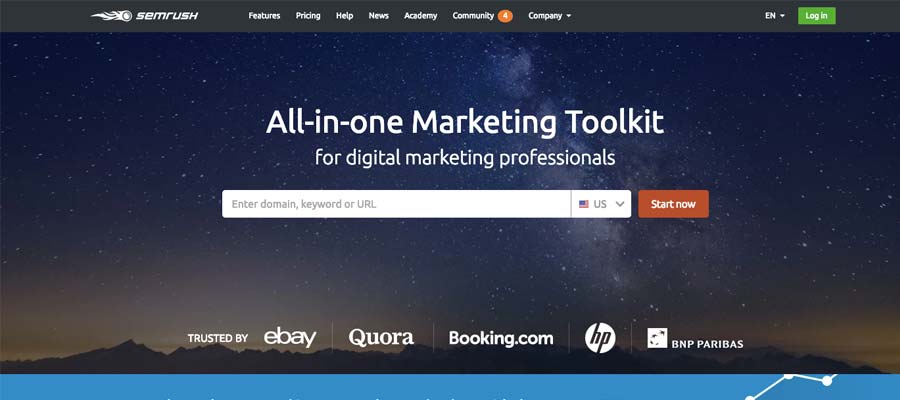
SEMrush is another golden growth hacking tool for any digital marketer. It is really the all-in-one marketing toolkit to help you optimize your website, grow, and succeed.
You should be thinking about SEO, even before you start writing content. You need to know which keywords you want to rank for, the competition for those keywords, and the monthly search traffic.
With SEMrush, you can do backlink research, conduct complete site audits, analyze your content and even analyze social media. In addition, you can even see what your competitors are doing when it comes to advertising.
This is incredibly useful information. Think about it. Your competitors probably have done loads of research to optimize their advertisements. You can replicate what is working for them which is a phenomenal place to start.
SEMrush will give you the ability to analyze and optimize which will lead to more traffic and eventually more sales. Similarly to Ahrefs, this tool must be a part of your growth hacking toolkit.
8. Ubersuggest
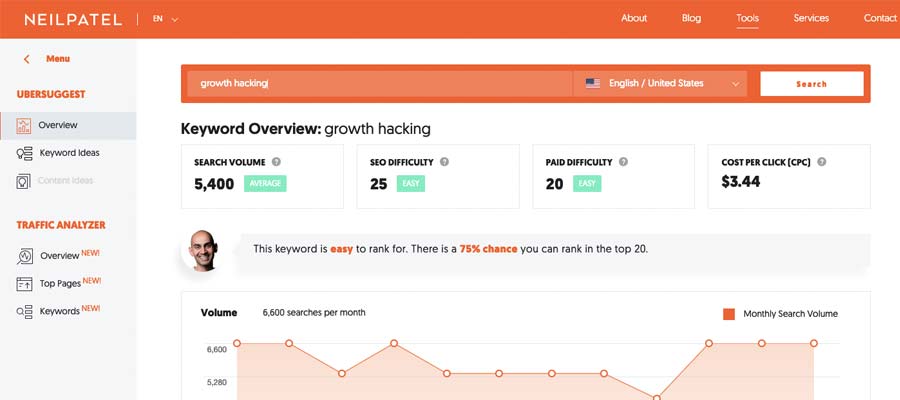
A tool from the king of digital marketing himself: Neil Patel. As you might expect, this is an awesome tool and the best thing: it is free!
Ubersuggest is a keyword research tool that you have to use before writing each piece of content. If you want to write a post about “video marketing”, Ubersuggest will give many other similar keyword ideas, such as “video marketing tips”.
The tool also shows you which pages are currently ranking for that keyword. That way you can see what your competitors did and outperform them.
In addition, Ubersuggest tells you how difficult it is to rank for a certain keyword. This is mission critical if you are going to invest in content marketing. The best way to rank for certain keywords is to first rank for long-tail keywords.
If you have a growth hacking job, you definitely need to be using Ubersuggest.
9. Moz
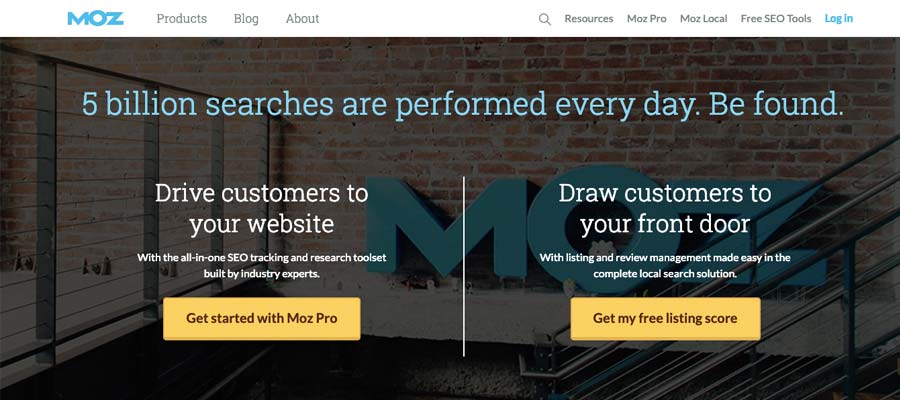
Moz is another goldmine marketing tool. The tool has loads of features that you can use to develop your growth hacking strategy.
Moz is the SEO toolset that's got it all: keyword research, link building, site audits, and page optimization insights, in one. They also have some free SEO tools available which are amazing.
Moz allows you to do keyword research and link building research. You can find out exactly which websites are linking back to your website and how many links you’ve gained or lost over a period of time.
Link building is a time-consuming activity. The best strategy is to create content so valuable that people will link back to organically because they like it so much.
10. WordPress SEO from Yoast
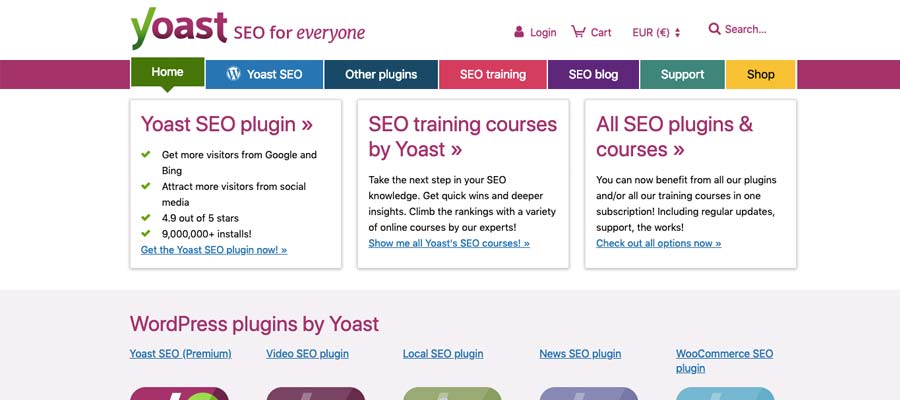
More than 650 million websites are using WordPress as their content management system. That is a huge amount of websites.
Yoast is a great plugin created for WordPress that helps you with SEO. The plugin checks your content and gives you suggestions to improve your SEO. This is incredibly valuable.
With Yoast, you can edit your meta description and title tags that appear in the search results of Google.
When you share your content on social media, you want people to engage with your content. You can improve your click-throughate by having intriguing social sharing images. Yoast lets you set custom Facebook and Twitter open graph images.
If you have a WordPress blog, you need to have an SEO plugin. Yoast is one of the best SEO plugins for WordPress to help you with your growth hacking endeavors.
11. Majestic
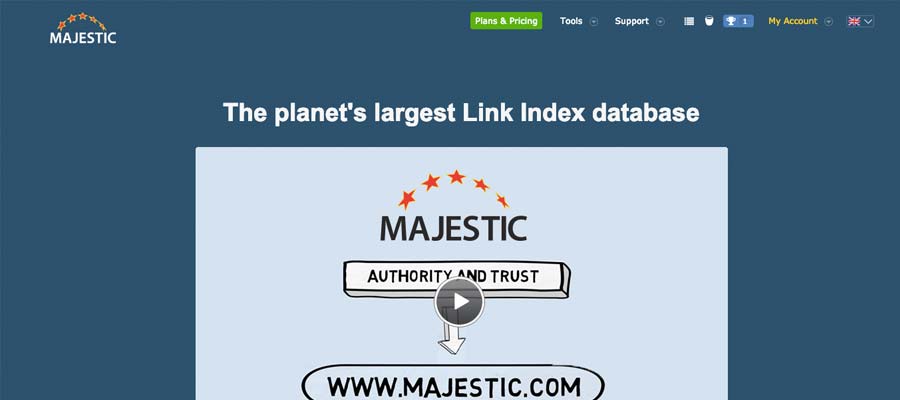
Majestic is a tool to analyze the backlinks going to your website. Link building is an integral strategy when it comes to demand generation but can sometimes be hard to report on due to slow indexation speeds. Majestic solves this problem as they frequently update their link index database.
With Majestic, you can analyze how powerful every link is, where your links are coming from, and which content is getting the most links.
It is a very visual tool which is great when you need to report on the success of your link building strategy.
12. Marketo
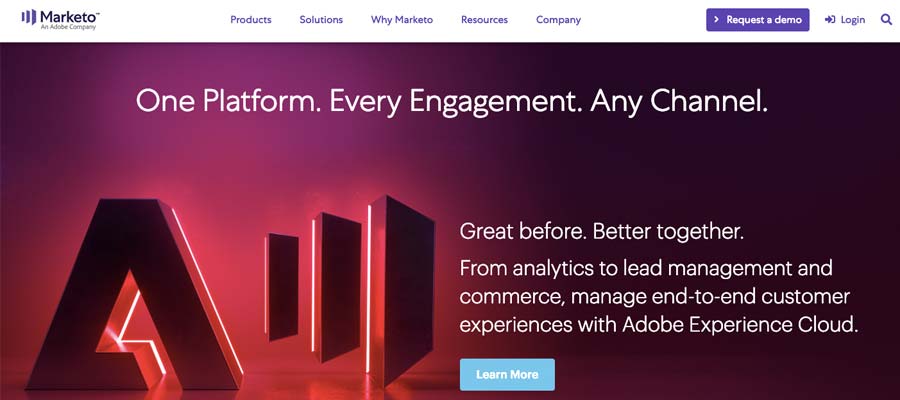
I’ve used Marketo a lot and it is a great tool for marketing automation, email marketing, and lead management. Marketo integrates with your website perfectly and helps you keep track of the entire buyer journey.
With Marketo, you can track every move of leads on your website. If they download something, you will know. If they visit a webpage, you will know. If they watch a video, you will know. You might think, what is the difference compared to Google Analytics… Google Analytics data is anonymous whereas with Marketo you have personally identifiable data.
Marketo lets you assign scoring to leads. For example, if a leads downloads a whitepaper, you give them 10 points. When the lead has reached 100 points, you can mark the lead as MQL.
Marketo lets you segment the database and therefore you are able to create an extremely personalized experience. You can send your leads different emails based on their location, or if they clicked in an email, or if they visited a certain page and much more.
Marketo also provides you with advanced analytical tools. You can track exactly the impact of your marketing campaign and calculate the ROI. You can track how many touches you need to average to convert a lead into an MQL and much more. A growth hacker should be data-driven and Marketo is a dream come true.
With growth hacking, you need marketing automation, email marketing, and lead management, and that is what Marketo is able to deliver.
13. Sumo
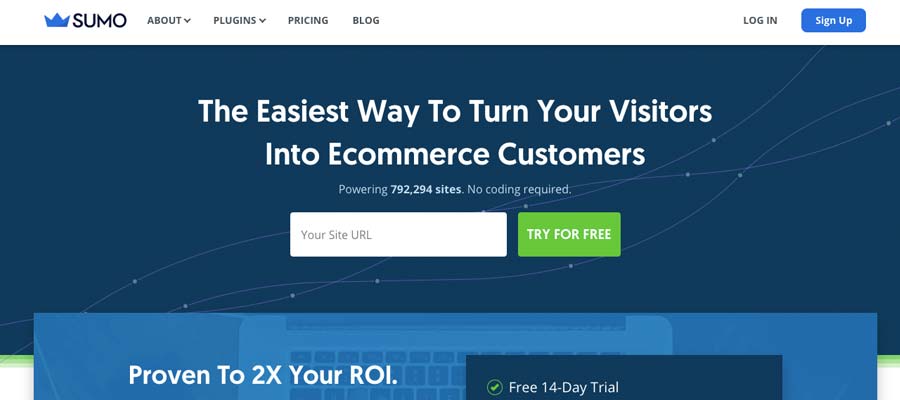
Sumo is a tool that helps you with converting your website visitors into leads and eventually sales.
Sumo can help with growing your email list through the use of pop-ups and integrates with major technologies such as Hubspot, Convertkit, and Mailchimp. The tool integrates nicely with WordPress and Shopify.
The tool has a free version so it is great for companies who are on a budget and trying to improve their marketing funnel.
14. Tailwind
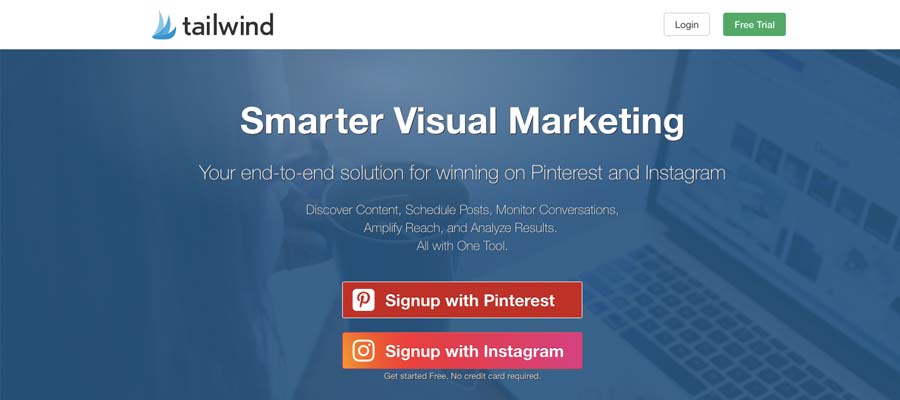
Tailwind is a little hidden gem for scheduling posts on Pinterest. Pinterest is often overlooked and people don’t pay much attention to it. Depending on your niche, Pinterest can drive an incredible amount of traffic to your website though.
Tailwind lets you schedule Pinterest posts to group boards which will greatly increase your exposure. Once you’ve built a following, you are going to see a decent amount of traffic.
While you are at it, you can also use Tailwind to start growth hacking Instagram, as the tool also lets you schedule posts to Instagram.
Analyze your niche and check whether your target audience is on Pinterest. If it is, you can’t afford to leave this out of your demand generation strategy.
15. HARO

Help a Reporter Out, or HARO is a great platform that you can use to create awareness and build backlinks to your website.
HARO is not really a tool, but it is an incredibly useful platform to get your content in front of reporters.
Whenever reporters are writing about a topic, they often need quotes or statistics. Reporters will send out a request to people subscribed to HARO to help them out. This growth hacking strategy is very effective as the reporters are requesting your help, instead of the other way around.
You can subscribe to HARO to receive daily emails full of requests. I advise making a filter in your email account that automatically places the HARO emails in a separate folder though. Sometimes you get 4-5 emails per day.
Reporters for major publications such as Forbes are often sending out requests.
16. Fiverr
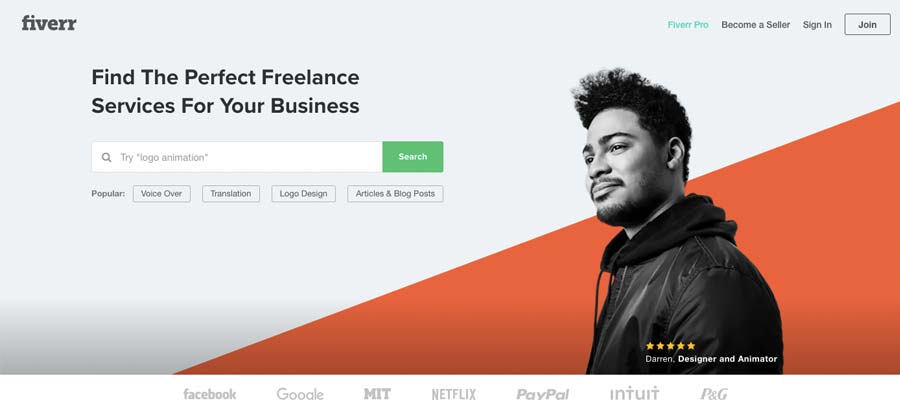
Getting headcount approved for a new full-time employee at start-ups can often be challenging. I’ve mentioned it before, growth hacking is a mindset about experimentation. If you don’t have the staff the experiment, what do you do?
Fiverr is not a tool but it is a platform for freelancers. This is a great place to start when you want some freelancers to execute on your growth hacking ideas.
There are a lot of talented people on Fiverr that are willing to help you. A great example is letting freelancers write blog posts for you.
Whenever you request a freelancer to write a blog post for your website, you have to be mindful of something.
People create much better content when they write about their own content ideas. My recommendation is to let the freelancers come to you with an idea for content. Pick the best one and hire the freelancer. This works much better compared to you giving freelancers a content topic.
Demand generation is also about having quality content on your website that people want to come back to. Let freelancers write about their own ideas and there will be a big chance that you will end up with better content.
17. Medium
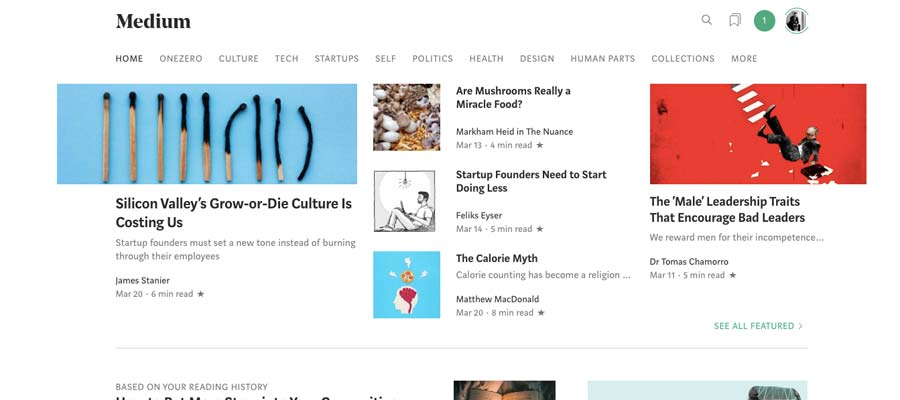
Medium is a publishing platform that most people use to publish blogs. Medium is a platform that is used by millions of people from every niche possible. Your target audience is consuming content on Medium, whether you like it or not.
Re-publishing content to Medium should be part of your growth hacking strategy. Often, people just publish content on their own blogs, but as a start-up, you probably won’t have many people reading your blog just yet.
Medium has a very simple feature to allow you to re-publish content to their platform. They add a canonical tag, so Google won’t penalize you for duplicate content. I’ve written a blog post about how to use Medium to drive traffic to your website.
18. LinkedIn Elevate

If you are growth hacking for B2B audiences, then LinkedIn Elevate must be part of your toolkit. B2B audiences are on LinkedIn, but how do you get your content in front of them?
LinkedIn Elevate is a tool that companies can use to make it very easy for your employees to share content on LinkedIn (and Twitter). Let’s say your company has 50 employees. If all those 50 people share your new content on social media, that is already an extreme reach that you are getting.
You have to make it easy for your employees to find content to share because often times they are very busy. Every time you create a new post, you can upload pre-defined social media posts to LinkedIn Elevate. All your employees will see this new content on the top of their feed.
With a press of a button, they can schedule the post for LinkedIn and Twitter. The tool also calculates the best time to share for your network.
Below are the average weekly statistics for using LinkedIn Elevate at my company. As you see this generates tremendous engagement from your employees sharing content.
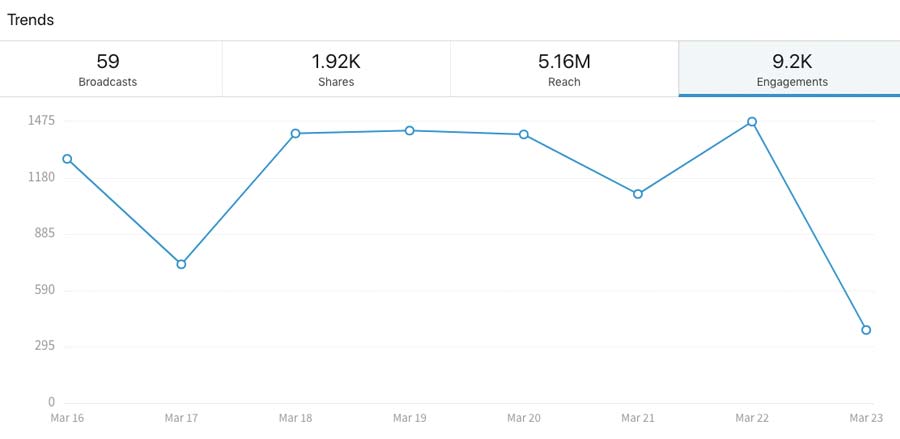
Growth hacking is about getting your content in front of many people as possible, and your existing employees can’t be overlooked to help you win in marketing.
19. Google Search Console
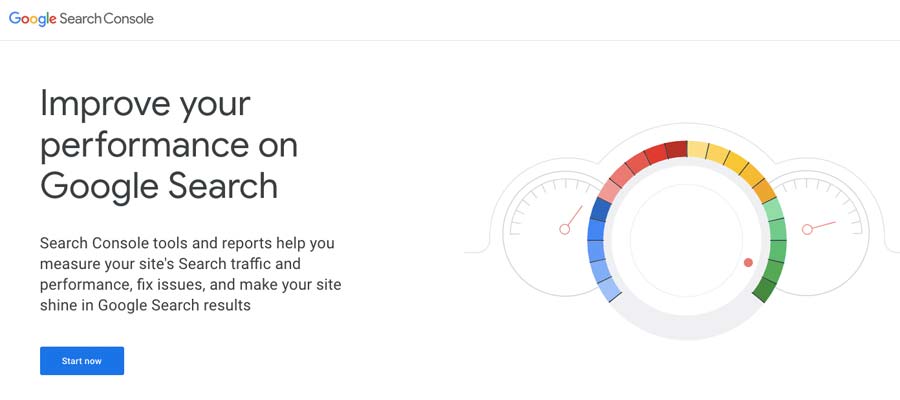
What if Google provided you with a tool to see which keywords you are ranking for? That would be ideal, right? Well, with Google Search Console, you can see exactly which keywords your website is ranking for.
Google Search Console helps you understand what people search for to find your website. You should be using these keywords and implement them into your content. This way you will see a huge boost in traffic in the upcoming months.
This is super valuable information coming straight from Google and frankly can’t be ignored. When you implement these keywords, you have to make sure that the content flows well and that you aren’t just loading the content with keywords for the sake of it. Using Google Search Console correctly makes organic growth hacking a whole lot easier.
Growth Hacking Activation Tools
20. Userlane
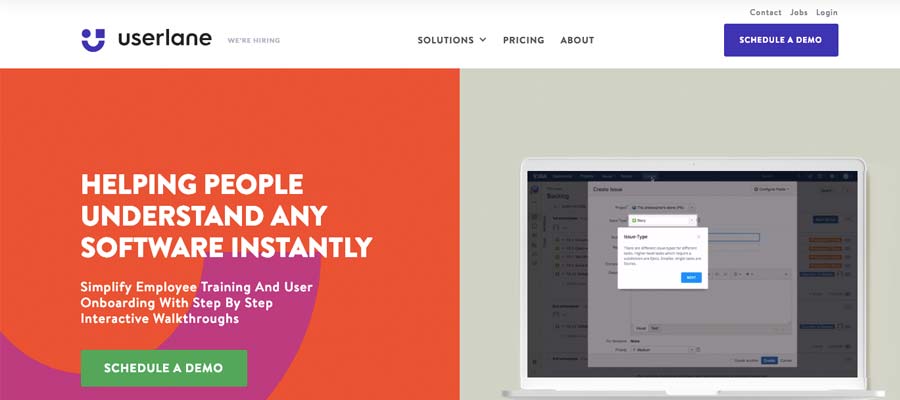
Imagine having stellar software, but your users don’t know how to use it. That would be a nightmare because they will just start using the products of your competitors.
Fortunately, this is where Userlane can help. Userlane is a tool that simplifies user onboarding with step-by-step interactive walkthroughs.
Growth hacking is not just about getting people to use your product. It is also about activating and retaining them. At the end of the day, if you have happy customers, they will do the growth hacking for you.
I’ve mentioned that a great growth hacking strategy is to offer a free product in a trial form. With Userlane, you can make sure that people understand how to use your product. Consequently, this will result in a higher trial-to-paid rate.
Onboarding new users should be a seamless experience. Straight away your new users should be overwhelmed by the value your product provides. Only then you will improve your customer retention rates.
21. Consumer Barometer
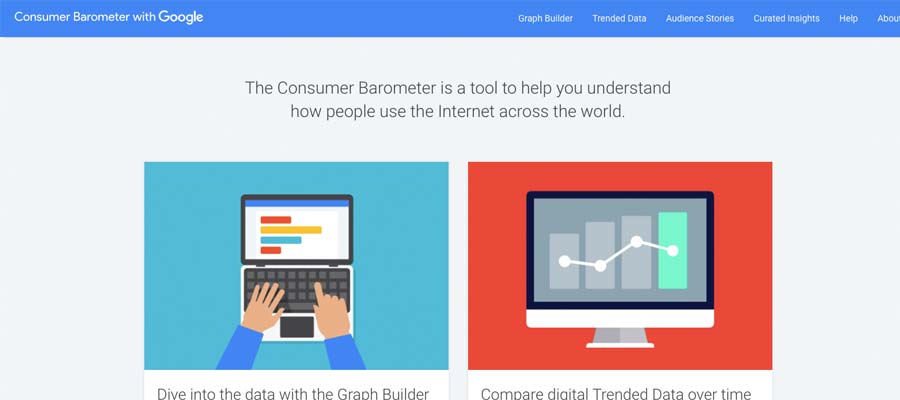
Consumer Barometer is a tool from Google to help you understand how people use the internet across the world.
Understanding the behavior of people on the internet is a true goldmine. If you want people to come to your website, you first need to understand the reason behind their browsing decisions.
An example: 79% of people in the United States use a computer for product research. 10% of people first heard about a product they bought through an advertisement. Information like this is incredibly useful for you to determine what channel you use in your growth hacking strategy.
22. Buffer
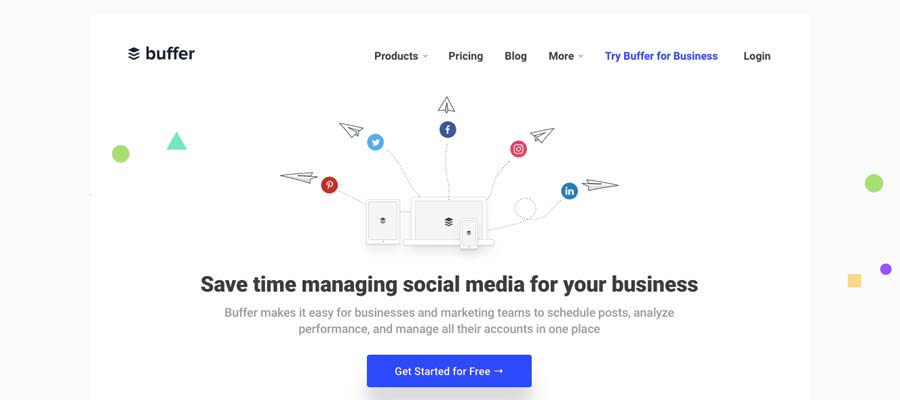
If you are serious about promoting your website on social media, you are going to need to scheduler tool.
With Buffer, you can start growth hacking Instagram, Facebook, Pinterest, Twitter, and LinkedIn. The tool lets you schedule posts for all these social media platforms.
Whenever you post on social media, you should only have one goal for your posts: maximize engagements. People often think that likes are most important. While likes are important, comments are much more important because it takes more effort to write a comment than to like something.
Whenever you create new content, you can post that piece of content to social media multiple times. People aren’t on social media 24/7. If you post something right now, the majority of your network is not going to see the posts.
Growth hackers often maintain the rule of 6. A good frequency to post the same content is every 2 months; so 6 times per year.
23. Hootsuite
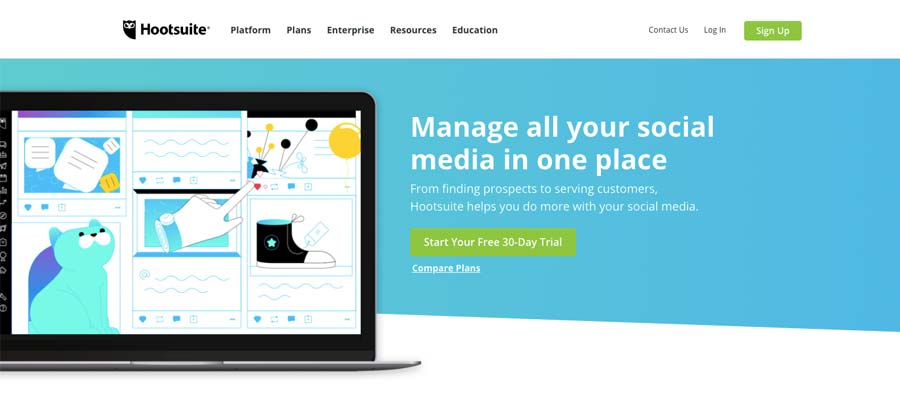
Hootsuite is another great social media scheduler tool. Hootsuite has got more advanced reporting tools than Buffer which makes it a bit easier to report on ROI.
Hootsuite lets you post to Twitter, Facebook, YouTube, Instagram, LinkedIn, and Pinterest. The tool also has great collaboration features which make social media management easier when you have multiple people responsible for social media.
24. Sprout Social
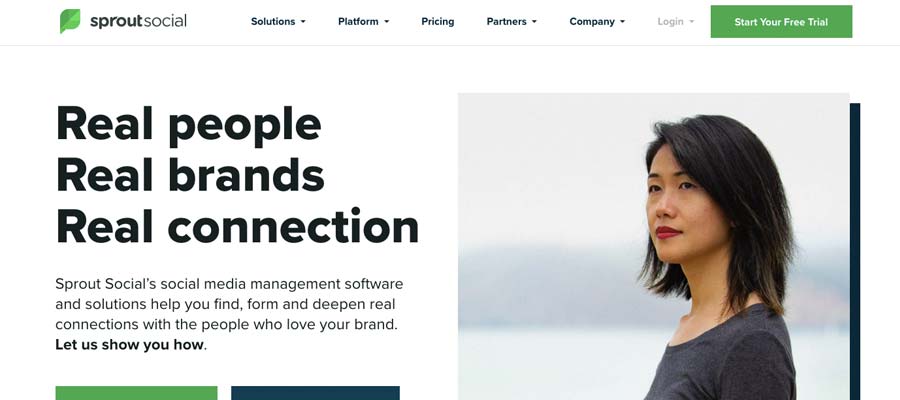
If you are really serious about growth hacking social media, then you should take a look at Sprout Social.
Sproutsocial is an advanced social media management tool which helps you form deep relationships with your followers.
The tool has very advanced analytical, social listening, and social engagement features. Naturally, the tool integrates with all major social media platforms.
As a social media marketer, you probably have trouble reporting on ROI. With Sproutsocial you can underscore the true ROI of social media through their reporting and monitoring features.
I’ve mentioned it before, but social media engagement is one of the most important metrics. You need to start building relationships with your audience and Sproutsocial makes that very easy for you. The tool has a unified inbox, so all the messages from your social media channels will be in one single inbox.
It also has functionality for team and workload management, so you will never have two of your employees replying to the same comments. The tool comes with a social media content calendar which is stellar to keep an overview of scheduled posts.
25. Hubspot
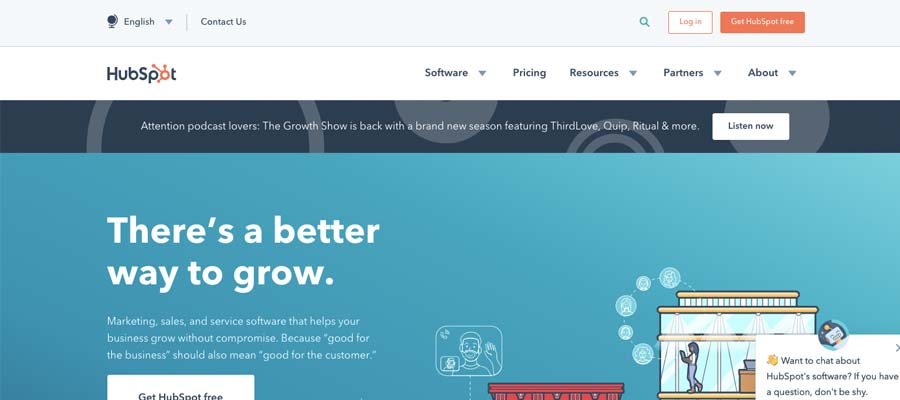
The team at Hubspot are the kings and queens of inbound marketing. What I love about Hubspot is their focus on customers. Hubspot supplies software for marketing, sales, and service to help you growth hack your company to the moon.
Hubspot provides a free CRM platform and in addition has many packages available for lead generation, marketing analytics, marketing automation, email automation for sales, scheduling meetings, and much more.
Basically, Hubspot provides all-in-one inbound marketing software for your entire team. It allows you to create landing pages without writing code, it provides real-time SEO suggestions, allows for advanced personalization, and lead management functionality.
Hubspot provides a bunch of tools for free, including chatbots for conversational marketing and live chat functionality.
26. Mention
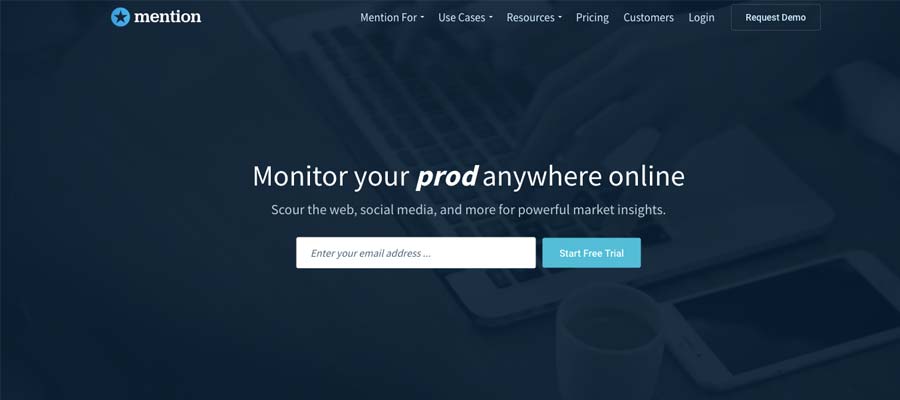
Mention is a media monitoring tool that helps you understand who is talking about your brand or your competitors.
Mention checks the web as well as social media in real-time. Imagine someone talking to you on social media or in a blog post. This is tremendously valuable information, especially at start-ups. If someone links back to your website, you can send them an email thanking them.
Sometimes, people will mention your brand name without linking back to your website. This is a great opportunity to reach out to them and ask them to include a link. Naturally, you can also monitor who is linking back to your competitors, and ask them to link to you instead if you have a more valuable article.
Mention also has an influencer tool that allows you to do research influencers in your niche. Building relationships with influencers can skyrocket your website. Be mindful that building a professional relationship is similar to a love relationship; it should always be giving and taking. Don’t try to use influencers for their network, but create a meaningful relationship.
Growth hacking is also about creating word-to-mouth advertisements. Mention lets you measure how much people are talking about your brands on the internet. This is a great baseline for measuring your brand awareness compared to your competition.
27. SurveyMonkey
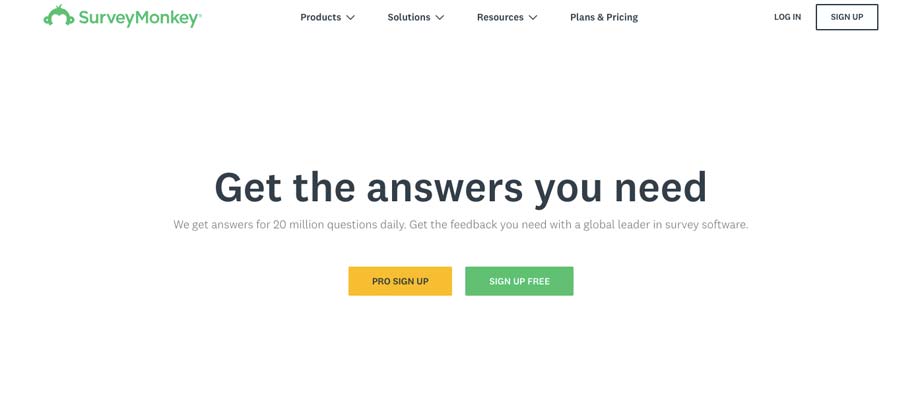
A part of customer and user activation is understanding their needs and wants. You always need to be looking for the next innovative feature to stay relevant to your audience. This can be accomplished by asking your users what features they’d like to see in the future.
SurveyMonkey must be one of the most popular free online survey tools out there. The tool integrates with all major external marketing tools such as Marketo, Eloqua, Mailchimp, Slack, Hootsuite, and Eventbrite.
People love statistics and research reports are a great lead generation tool, especially in B2B markets. If your email list is big enough, you can use SurveyMonkey to collect all the data you’d require for a research report. This is a phenomenal B2B growth hacking strategy.
At the end of the day, you need to measure the satisfaction of your customers (NPS) and employees (eNPS). There are many ways to do it and SurveyMonkey provides one of those ways.
28. Bayesian A/B-test Calculator
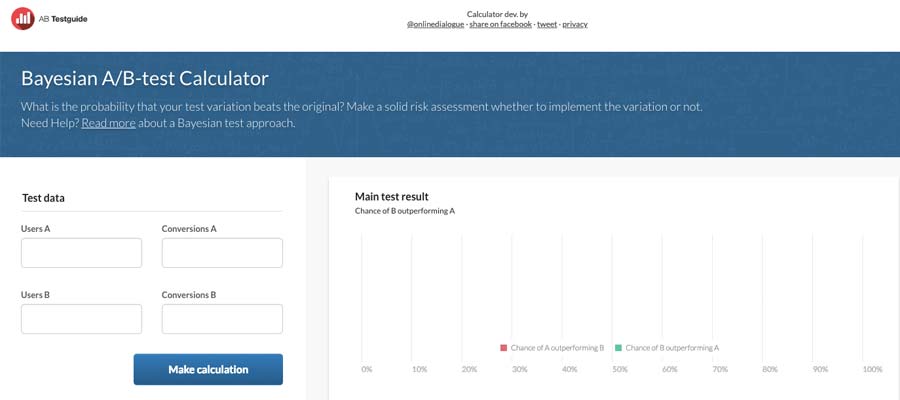
As a growth hacker, you need to be testing everything you do because you are always looking to optimize things for growth. You always need to be innovating to stay ahead of the curve.
A Bayesian evaluation method ensures that test results and conclusions can be communicated without any statistical terminology. A Bayesian test evaluation gives a much simpler answer to the question of whether variation B outperforms the current situation, namely with a chance.
29. Elementor

If you have a WordPress website, you are missing out if you don’t have Elementor installed to design your website. Elementor is basically a visual page builder, meaning you can design your website and landing pages without writing any code.
I’ve designed Markletic using Elementor and I couldn’t be happier about the results. Elementor comes with functionality such as header and footer design, single posts design, and more.
Elementor allows you to design and develop your entire website without touching any code. This is great for teams who can’t afford to spend weeks developing websites.
Elementor also comes with a pop-up functionality. Similarly to OptinMonster, Elementor allows you to design pop-ups and launch them with functionalities such as exit intend.
The tool also comes with many professionally developed templates which you can use to speed up the development of landing pages. Elementor really deserves a post on its own, therefore I’ve created this post to outline all the growth hacking benefits to using Elementor.
Growth Hacking Retention Tools
30. Google Analytics
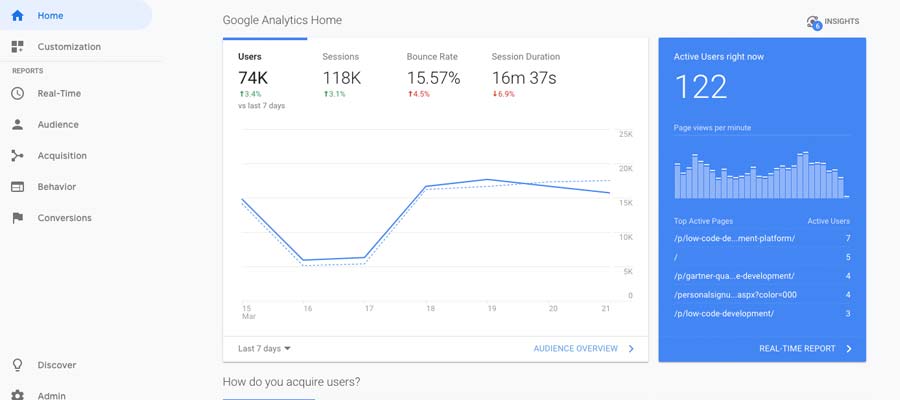
This one shouldn’t be a surprise. If you own a website, you should have analytics installed on it to see what your users are doing. Google Analytics can be used for a myriad of reasons.
The most important reasons for using Google Analytics is to see where your traffic is coming from and which content is performing well.
Ultimately, you want most of your traffic coming from organic sources because this would mean you did a great job at SEO. However, it must be noted that you need to keep your content updated. If you don’t, you will start seeing a decline in traffic.
Use Google Analytics to check which content performs well and then analyze why. You will always have some pages that drive the majority of your traffic. What did you do to make that page perform so well? Which keywords did you use? How many backlinks are going to that page? Those are some of the questions you should be asking yourself.
You also want to be looking at bounce rates and average time on site. These are key retention metrics and understanding those metrics will allow you to make changes to your website to retain users.
31. YouTube
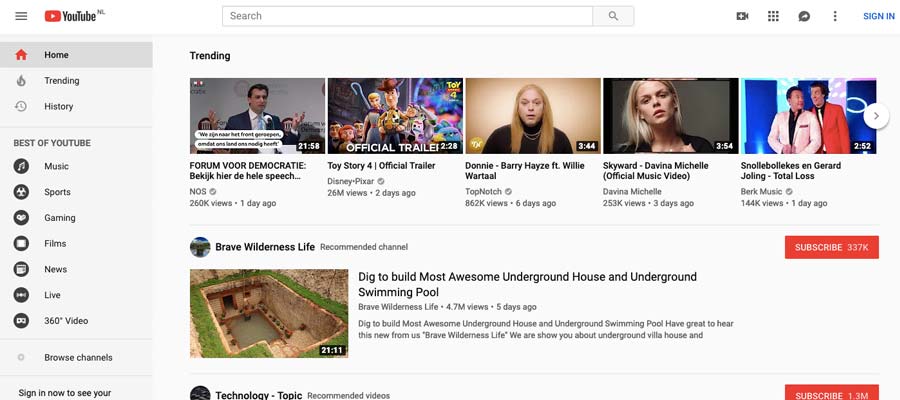
If you want people to use your product, show them how it is done! Through video, you can reach an audience that you wouldn’t be able to reach elsewhere. Your growth hacking strategy should have an omnichannel focus. Let’s face it, your target audience is on YouTube.
In a previous post of mine about video marketing, I’ve told you that 81% of people have been convinced to buy a product or service by watching a brand’s video. Imagine not including videos in your marketing strategy? You’d be missing the boat.
So what exactly are the benefits of using video marketing as a tool to reach and connect with your audience? The 3 main benefits are:
- Shareability. Videos are much easier to share across all the marketing channels.
- Videos build trust.
- It is great for SEO!
Growth Hacking YouTube is brilliant in developing an engaged audience. Videos are easy to consume content if set-up properly. You have to make sure to “hook” people within the first few seconds of the video. Here are my secrets to winning at video marketing.
Once your videos are created, you can use them in your blogs and share them on social media to increase awareness.
32. Facebook Pixel
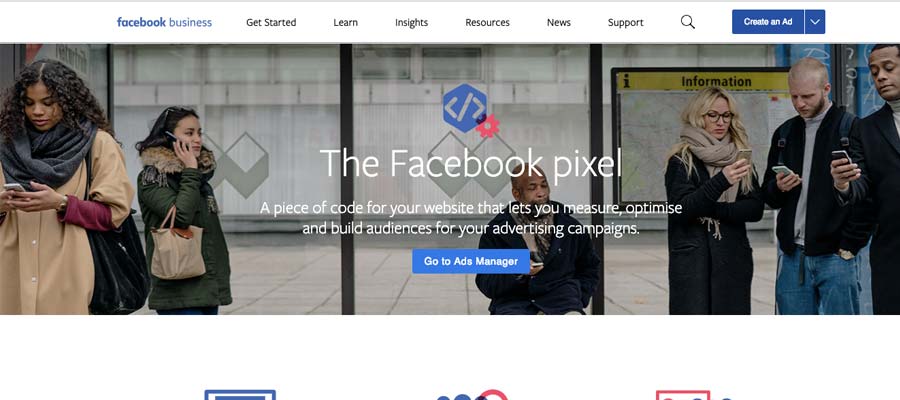
Facebook Pixel is not really a tool, but it is a piece of code that you need to include on your website.
The code will allow you to collect data about your users and communicate it back to Facebook. If you are considering Facebook advertisements, this is an absolute must. Facebook Pixel allows you to do remarketing on Facebook.
Did you ever visit an online store, and then you logged into Facebook and suddenly you see ads of the products you were just looking at? Well, guess what, that is done using a Facebook Pixel.
Remarketing has far better results than cold advertising and therefore this is a great social growth hacking tool.
33. Google Ads
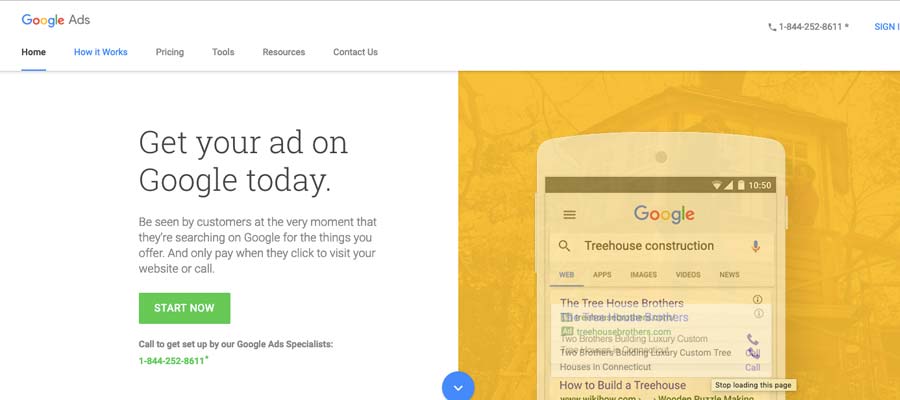
The platform where major companies burn millions of dollars on demand generation; Google Ads must be the most famous advertising platform out there.
Launching a new company, product or website can be extremely hard. At first, you won’t have a lot of traffic coming to your website through organic ways. If you don’t have traffic, how are you going to make sales?
Google Ads basically allows you to buy search traffic and it can be very effective. It can also be a great waste of money if not optimized correctly. When setting up Google Ads campaigns, make sure to be highly targeted. If you are optimizing for conversions, make sure to set those goals on Google Analytics.
Your audience is on Google and using their advertising platform is an excellent way to reach them. Google Ads comes with a few neat tools of themselves such as the keyword planner tool.
With this tool, you can see all the search traffic for certain keywords and the competition. As a new website, it is best to go after those long-tail keywords.
34. HotJar
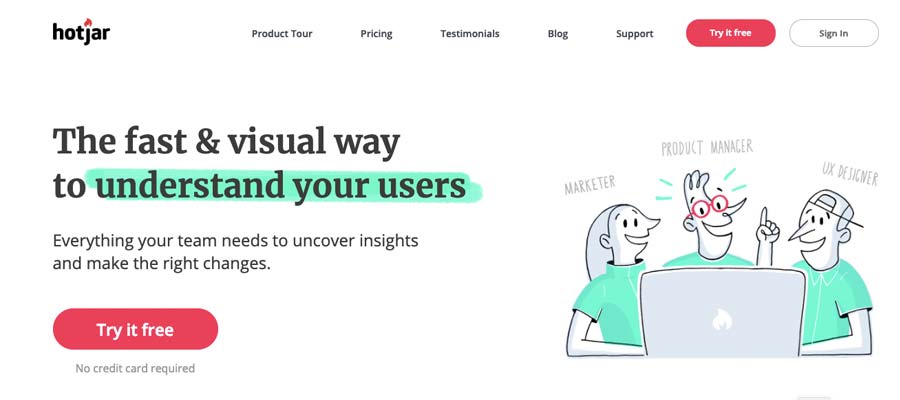
Understanding your users is so important but at new companies, this is often overlooked. You should want to understand what people do on your website, what the conversion funnel looks like, and getting the feedback of your users. This is where HotJar comes into play.
HotJar provides tools to visually understand what your users are doing. HotJar tracks everything that people do on your website and visualizes this data in easy to use heatmaps.
HotJar also makes session recordings. This way, you can see where people move their cursor to, what details they enter in a form, and you can see how far people scroll before exiting the page.
Understanding your users is immensely valuable and you need to measure whether your website is performing as expected. As mentioned before, Growth Hacking isn’t just about acquiring users, it is also about retaining them.
35. Five Second Test
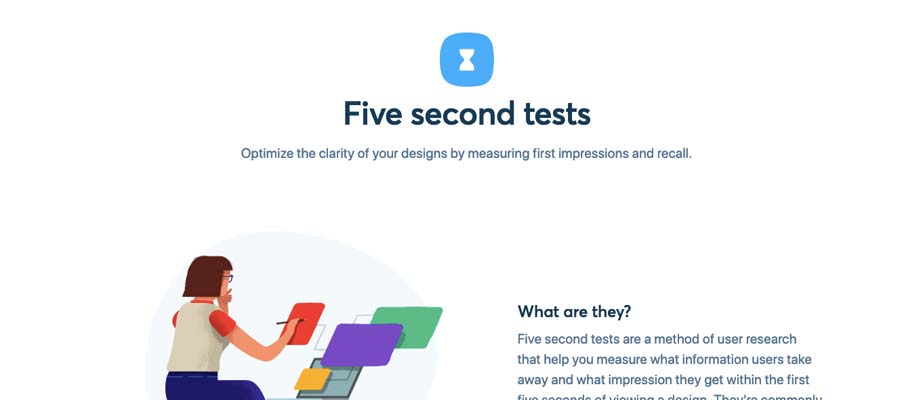
Retaining your users is all about providing a stellar experience. Designing gorgeous websites is one thing, another one is testing to see if those designs perform well.
This is where the Five Second Test comes into play. Five Second Tests is a method of user research that allows you to measure what information users consume and what their impressions are within the first 5 seconds of viewing a design. People have a short attention span online, so it is important to hook them from the beginning.
Five second tests determine if your landing pages are getting the message across and answer questions such as:
- What is the purpose of this landing page?
- What are the main elements you can recall?
- What feeling did you have when looking at this image?
- Did the design/brand appear trustworthy?
- What was your impression of the design?
Testing user behavior is a growth hacking technique that can’t be overlooked. You spend a lot of effort and time getting people to come to your website, the next step is retaining them.
36. MOAT
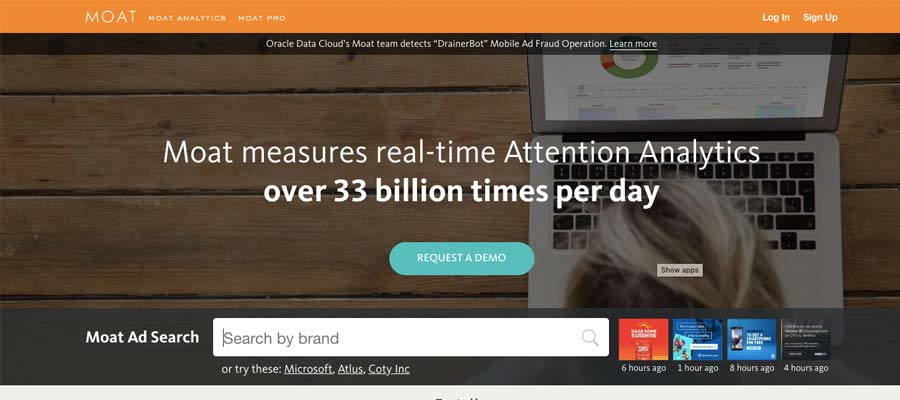
MOAT is a digital marketing analytical tool that provides intelligence into the market. With MOAT you can search what display advertisements your competition is using.
This is incredibly valuable information when it comes to optimizing your ads. Why reinvent the wheel? Analyze what your competition is doing and make your advertisement even better. It also analyzes the audience that you are reaching and how you are performing.
MOAT provides over 50 metrics in video and display and provides excellent advertisement intelligence. If you are going to spend money on ads, make sure to analyze the performance properly.
37. CoSchedule
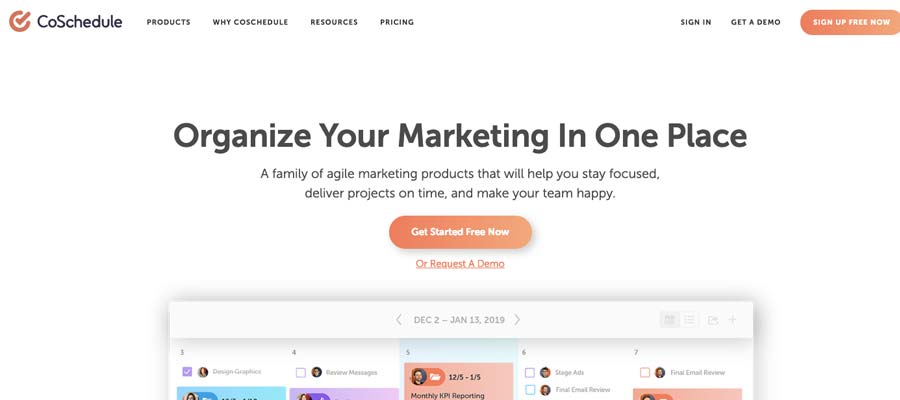
CoSchedule is a tool very suitable for in-house marketing teams or growth hacking agencies.
CoSchedule provides a platform that allows you to create an integrated marketing calendar with team management functionality.
When you are creating your content marketing plan, you need to think about timings. Where is your target audience based and what would be the best time to get blogs and social media outings in front of them?
CoSchedule combines the marketing and social media calendars so you have a clear overview of your omnichannel marketing approach. You can even connect your email marketing platform to include that as well.
The tool also comes with a neat feature called ReQueue. This essentially allows you to automate your social media and therefore easily enlarging your social media footprint. ReQueue will detect if there are gaps in your social media calendar and automatically fill the gaps with evergreen content.
If you have an in-house marketing team, or you are working at a marketing or growth hacking agency, CoSchedule can really save you a lot of time with managing editorial and social calendars.
38. Reddit
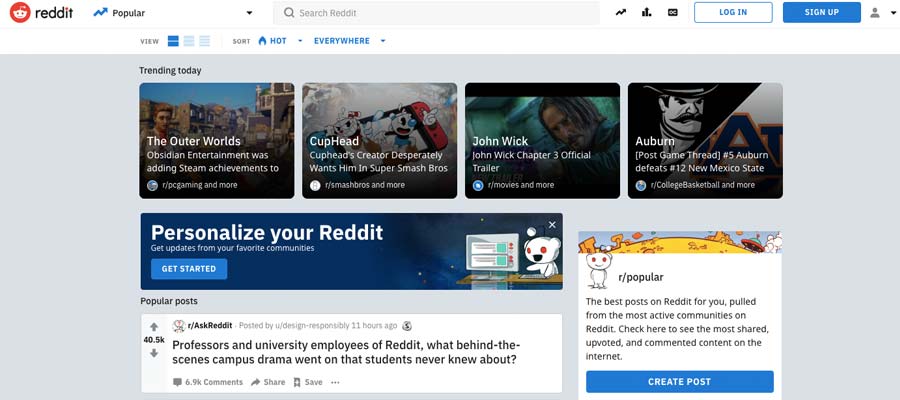
Reddit is a huge online forum with a community consisting of millions of active users daily. On Reddit, there are communities for everything - literally everything. Often times, people are looking for advice and tips on Reddit and there is where you can help.
Let’s say your niche is about dogs and you’ve just created a post about 10 foods for good dog dental health. You can summarize this post on Reddit and link back to your article. You have to provide value on Reddit and not just create posts for the sake of linking back to your website. People will see right through it and they will delete your post.
Growth hacking Reddit starts by providing value to the Reddit community. When you provide value, people will upvote your posts resulting in more views.
39. Quora
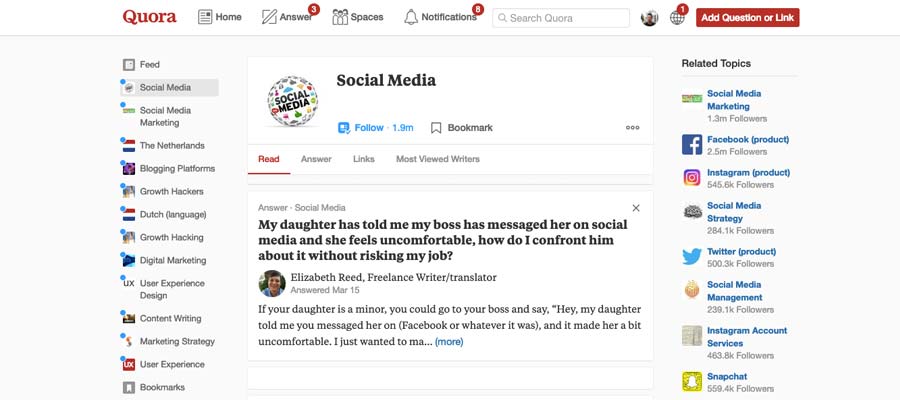
Quora is an online community where people come to ask questions. If you have a question, ask it on Quora and people will answer.
You can subscribe to topics about your niche and when someone has a new question, you can answer them and link back to your website. Repurposing your posts for Quora is a neath growth hacking technique. The more value you provide in your answer, the more likely it is that people will visit your website.
Quora also provides tremendous inspiration for future blog posts. When people ask questions about something, it means there is a need for content about that subject. Analyze the questions and make a blog post out of it.
40. Cloudways
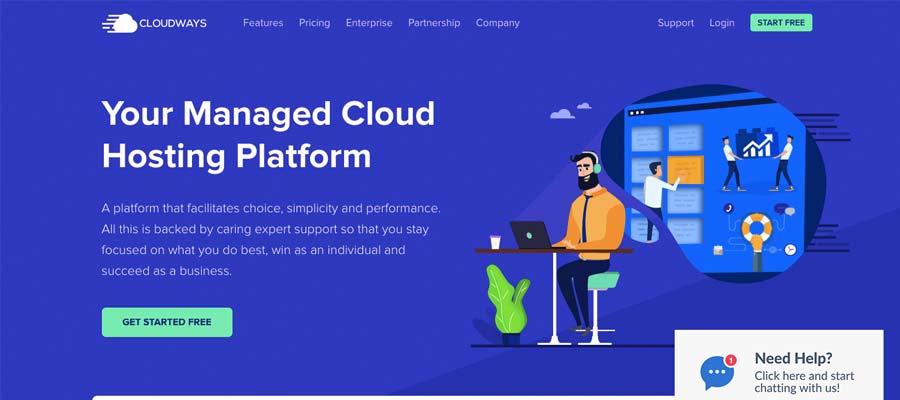
Cloudways is a cloud hosting platform for your website. To retain people, you need to have a fast website. People have a short attention span and they will just get annoyed when your page is loading slowly. Google also dislikes slow pages and will penalize you for having a slow website.
Make sure your growth hacking efforts don’t go to waste and get fast (affordable) hosting. You can spend hours optimizing your website, but optimizing will only get you so far. If you have a slow server, you can optimize all you want but you will still have a slow website.
Always aim for the best user experience possible and only then people will be coming back to your website. Here is how to set-up a Cloudways website.
41. Subscribers
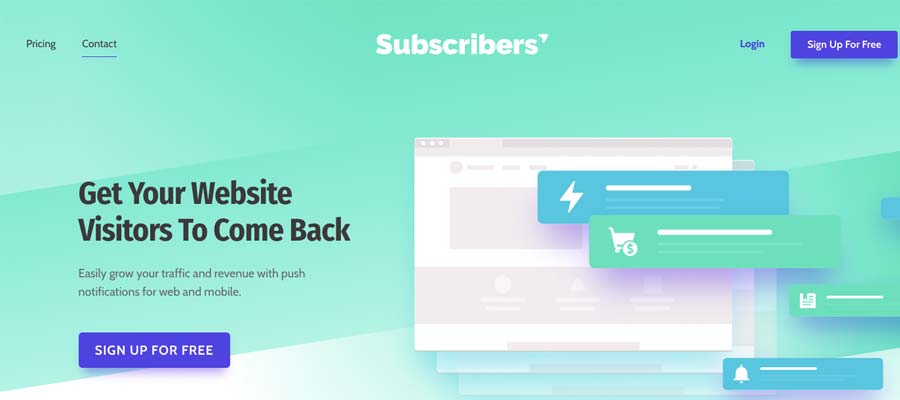
We’ve already covered some tools to get people back to your website but I’m not done yet! Subscribers is a tool developed by Neil Patel that allows you to build a push notification subscriber list.
To retain users, you need to have as many channels as possible to get people to return to your website. This is part of the omnichannel marketing strategy.
With Subscribers, you can send push notifications to your subscribers when you’ve created new content. Subscribers currently works on Chrome, Firefox, Safari desktop, and Android mobile.
Before people remember your brand, you need to re-engage your visitors at least 10 times. Therefore, sending push notifications is a great growth hacking technique to re-engage visitors and get them to remember your brand.
42. OneSignal
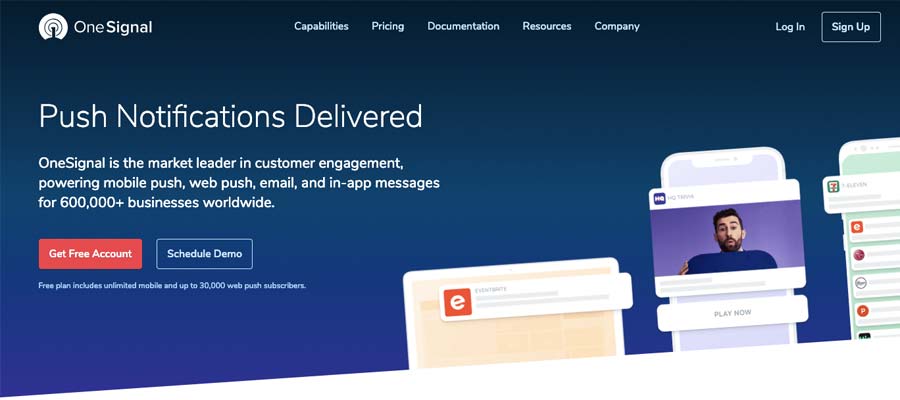
OneSignal is another tool to send push notifications to your subscribers. With OneSignal you can send push notifications to your first 30.000 subscribers for free.
In addition, you can A/B test your push notifications, segment your subscriber list, and can localize them for different languages. Being able to segment your subscriber list is valuable because you probably have visitors from different time zones.
You don’t want to send push notifications to people from the US and Europe at the same time. If you send a push notification at 9 AM in Europe, people in the US will still be sleeping. This will harm your open rates, so you should want to time your push notifications perfectly.
OneSignal works on all major platforms including web, IOS, and Android.
Growth Hacking Revenue Tools
43. Intercom
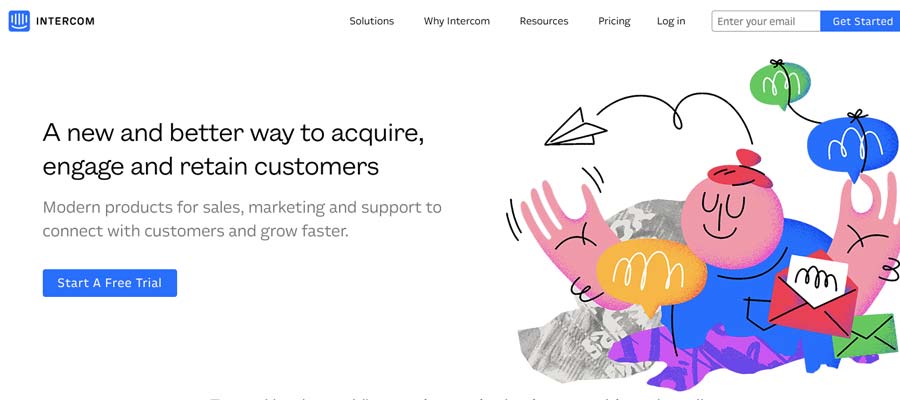
So you’ve worked hard to get people to your website, now it is time to actually convert those people and get some revenue. Intercom is a customer messenger platform on your website that allows people to start a live chat with your customer service team.
This is a great way to retain users, send them to the correct landing pages and ultimately convert them. In the past, I’ve used Intercom to send people from certain industries to industry-specific landing pages. This works wonders for on-site account-based marketing.
Intercom allows you to build a personal relationship with your website visitors. It allows you to answer questions they might have instantly, and it provides them a low barrier way to request information. Using live chat, I’ve seen the conversion rates from lead to MQL shoot through the roof and I can’t stress the importance of a personable experience enough.
Especially if you are growth hacking in B2B SaaS companies, the best way to differentiate yourself from the competition is to build a connection with your audience. A great channel for this is B2B Events. If you fail to do so, people will leave your website and there are probably many competitors that offer similar services.
44. Drift
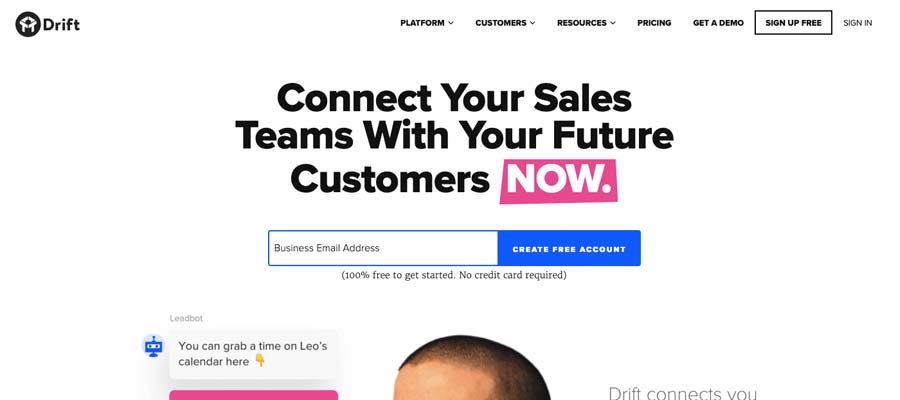
Drift is another conversational marketing platform that allows you to include a live chat functionality on your website.
In addition, you can also create chatbots that help to convert your visitors when your customer service staff isn’t available. You can connect Drift to your Gmail account and create email sequences which take your marketing automation one step further.
Drift is also great for account-based marketing, as it can notify your sales team when your named accounts visit your website. It can even start a conversation on behalf of the sales representative.
Demand Generation from your named account list (or target account list) is often hard and costly. Therefore, you want to have tools in place that optimize conversion when your named accounts do visit your website.
With Drift, you can also redirect those visitors for your named accounts to an industry-specific landing page. This way, the content will be much more relevant and you will see an increase in your conversion rates.
45. Zoom
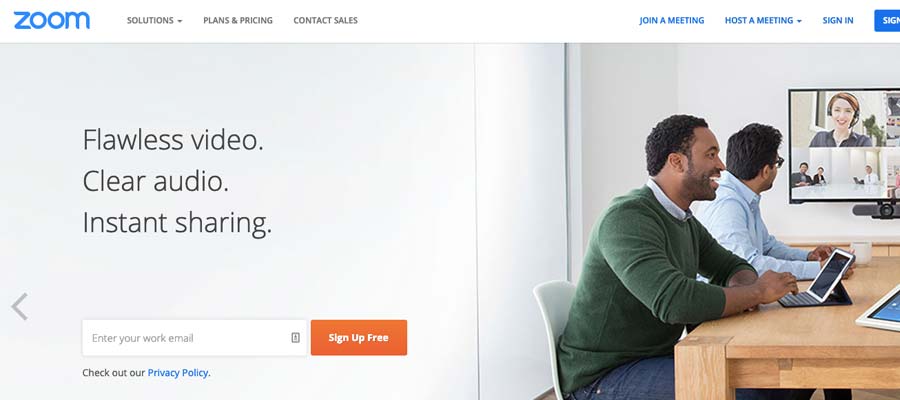
Zoom is a neat tool for video conferencing and webinars. So why exactly do I consider Zoom to be a growth hacking revenue tool?
At the end of the day, people buy from people. You’ve worked hard to convert leads to MQLs and you’ve scheduled an appointment with the prospect. Now it is time to bring it home and through video conferencing, you can build a better relationship with people than through voice calling.
Of course, face-to-face meetings are more valuable, but if prospects are geographically dispersed, you don’t always have the luxury to meet in person.
Building a good relationship with your prospects will significantly improve your conversion rates and will lead to more sales.
46. On24
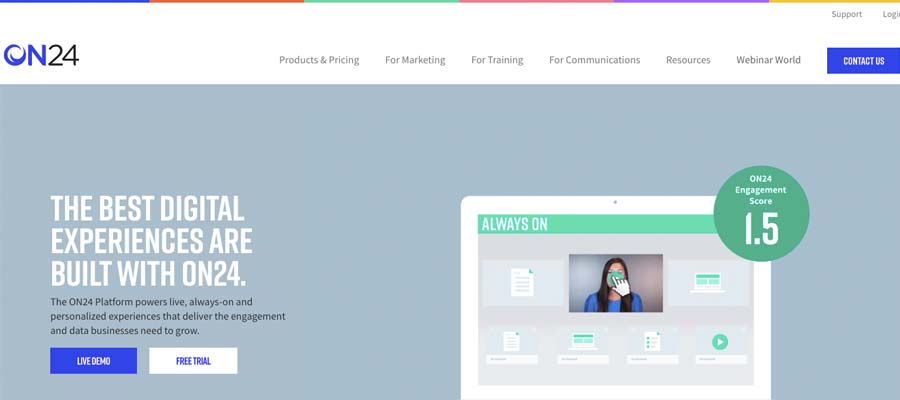
I’ve used On24 a lot for webinars and it has worked wonders. Webinars are a low-barrier way for people to get to know your product through demo webinars.
I’ve mentioned before that happy customers are the best advertising you can get. Well, guess what. If you can do a joint webinar with one of your happy customers, you will see your conversion rates shoot through the roof.
The main benefit of using On24 for webinars is their on-demand functionality. Once you’ve hosted your webinar, the webinars stay available on-demand for people to watch at a later stage.
On24 also allows you to prerecord webinars and play them back at a later stage. I’m a huge fan of it because it eliminates the risk of internet failures. Once the webinar finishes, you can choose to switch to a live audio connection so that you can answer questions that people might have.
This still provides a super personal experience but eliminating some of the risks. Additionally, you can perfect the webinar and playback the best recording.
On24 comes with a Q&A widget that allows your audience to ask questions. Webinars should be part of your growth hacking strategy to improve your conversion rates.
47. Zapier
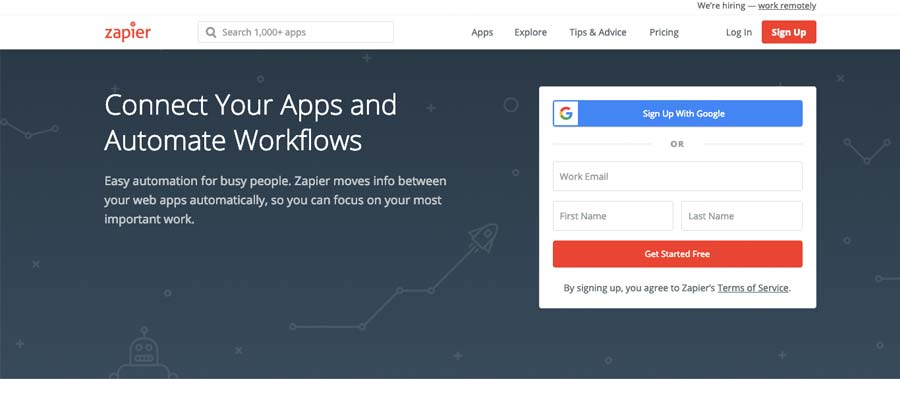
If you are serious about growth hacking, you should also be serious about marketing automation. This is where Zapier comes into play.
Zapier is my go-to tool to automate everything across multiple applications. Zapier is a tool that moves information between web applications. It integrates with thousands of online tools and it can automate a lot of your online life. In a nutshell, Zapier allows apps to talk to each other.
Zapier works with the concept of workflow. You will have triggers that start the workflow and actions that automate things.
Some examples of workflows
Someone fills in a contact form on your website, Zapier will upload all the attachments to a Google Drive folder and will send you a notification on Slack. Additionally, it will add the lead to Mailchimp.
Someone tweets and mentions your brand. Zapier will add the Tweet go a Google Sheet.
You’ve created a new post on WordPress. Zapier will automatically post the new blog to all your social media channels.
As you can imagine, this will save you a lot of time. The time that you can spend on your next growth hacking experiment. With marketing automation, you can send notifications faster and it eliminates the possibility of human error. With Zapier you can collect and store data automatically which allows for data-driven decisions. As a growth hacker, you always need to be making decisions based on data. Therefore, I consider Zapier a revenue tool.
Growth Hacking Referral Tools
48. Outreach Plus
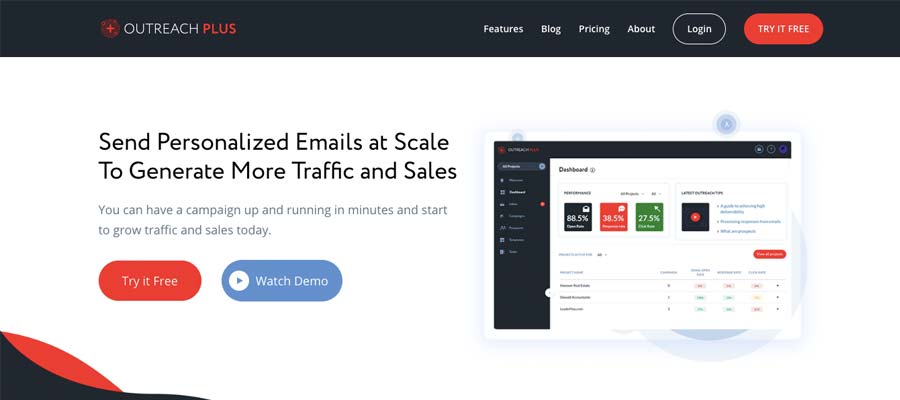
An important part of SEO is building domain authority. Websites with a higher domain authority will rank faster than websites with low domain authority.
One way to increase your domain authority (DA) is through link building. You can use Moz to analyze your DA. So what does this have to do with Outreach Plus? Glad you asked.
Outreach Plus is a tool for email marketing focused on reaching out to people. The main difference between Outreach Plus and for example Mailchimp is that with Outreach Plus you connect your own email account to the platform.
This means that the tool will also see the replies that people send to your email marketing campaigns.
Back to link building. With Outreach Plus, you can easily create email campaigns with the purpose to build links and promote your content. The tool allows for personalization and automation.
For example, you can create an email campaign for link building purposes and customize each individual message, if you want. If people reply to your email, the response will be in Outreach Plus which makes it very easy for you to analyze whether that person is likely to link back to your website. The tool also applies scoring to leads and you can put people in groups.
While link building for new websites is hard, it must be part of your growth hacking strategy. Without a good domain authority, your website won’t take off.
49. Hunter
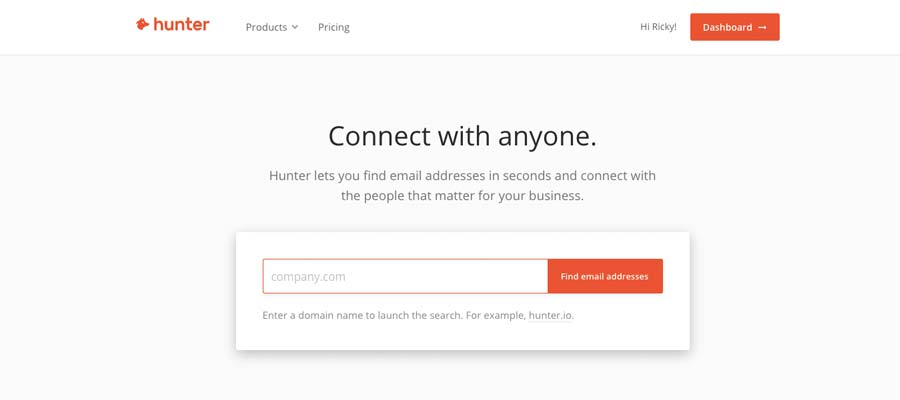
We’ve already determined that link building is critical for exponential marketing growth, but how do you get email addresses?
This is where Hunter comes into play. Hunter is a tool that lets you find email addresses of people for free. If you are like me and live in Europe, you might be concerned about the GDPR regulations. If you are reaching out for legitimate business purposes, and not sending email newsletters, you don’t have to worry about anything.
Back to Hunter. Hunter works by looking at email patterns from large companies. For example, at Markletic, we use the email pattern: firstname.lastname@markletic.com. As an example, my email address is ricky.wolff@markletic.com. Hunter gets this information by scraping websites and looking for email patterns.
Hunter might actually not have the email address of everyone, but if you know the email pattern used by a company, it is pretty easy to figure out the email address of someone.
Especially if you are growth hacking for B2B companies, this is a stellar way to kick-start your link building or guest posting initiatives.
50. Find Emails
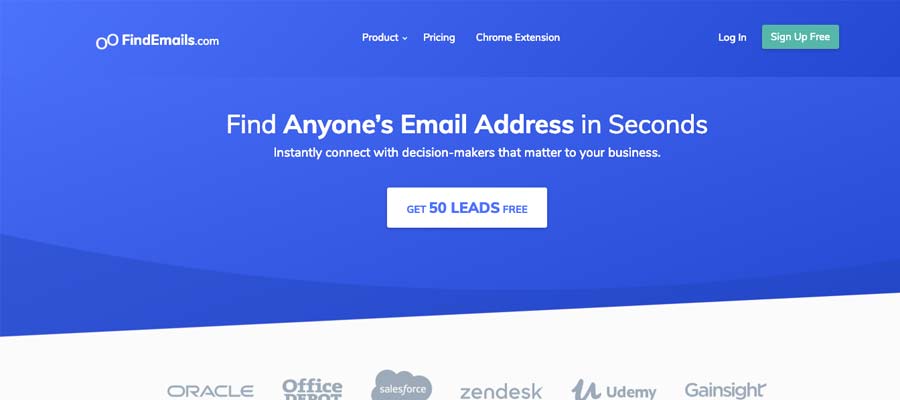
Find Emails is another tool to find emails for outreach purposes. Find Emails only provides verified emails by analyzing aspects such as patterns, mail servers, MX records, and names.
It is critical that you only send emails to verified email addresses. If you don’t, it can hurt your sender score and this could mean your domain gets blacklisted.
Find Emails also allows you to buy lists of email addresses that could help in frontloading your outreach initiatives.
The tool also has a Google Chrome extension which allows you to find and verify emails while you browse the web.
Demand generation starts by introducing people to brand. Getting people to your website through outreach initiatives such as link building is your first step in converting leads into business.
51. Buzzsumo
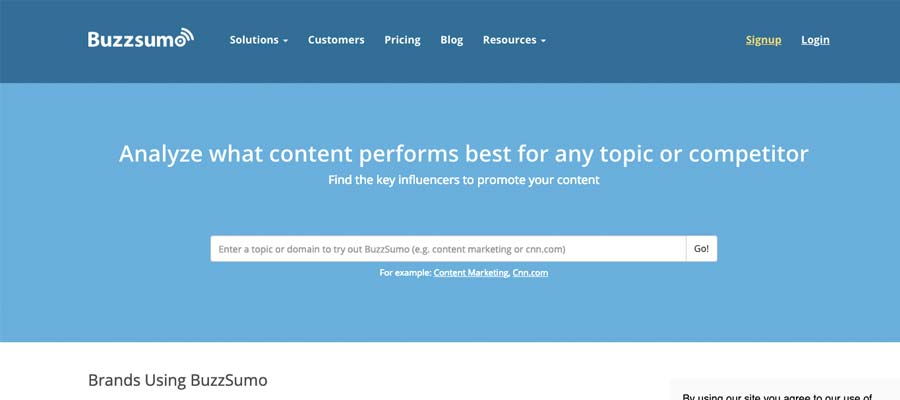
Of course, Buzzsumo belongs to any growth hacking tool list. Buzzsumo allows you to analyze what content works well and what doesn’t. It also allows you to identify influencers in your niche.
People are always looking for credible information. One way of checking credibility is by looking at how many people shared a certain piece of content on social media. This is called social proof.
Similarly, you need to be checking the social proof of your competitors. What content is performing well in terms of social shares of your competition? If you know this, you can apply the skyscraper technique and start creating better content. You already know it is content that will resonate well with your audience.
If you don’t have the analytics on your website, you can also use Buzzsumo to determine your own social footprint. Take the best performing content and go back to it to update the content. Do this with your best 20 posts and in time your content will take off.
A growth hacking strategy is to analyze what works well for your competitors, then replicate and improve it. Buzzsumo is the place to go for content inspiration.
10 Stellar Growth Hacking Examples
Let’s take a look at some of the growth hacking strategies used by major companies that have achieved exponential business growth. This should give you some inspiration for your first growth hacking campaign.
1. Hubspot
Hubspot achieved massive business growth partly due to its free tool offerings. Not only do they provide a great first insight into their product offering by providing a free CRM. They also have a website grader tool that allows you to check the SEO friendliness of your website. There is a huge market for SEO and Hubspot tabs into that by providing a free tool.
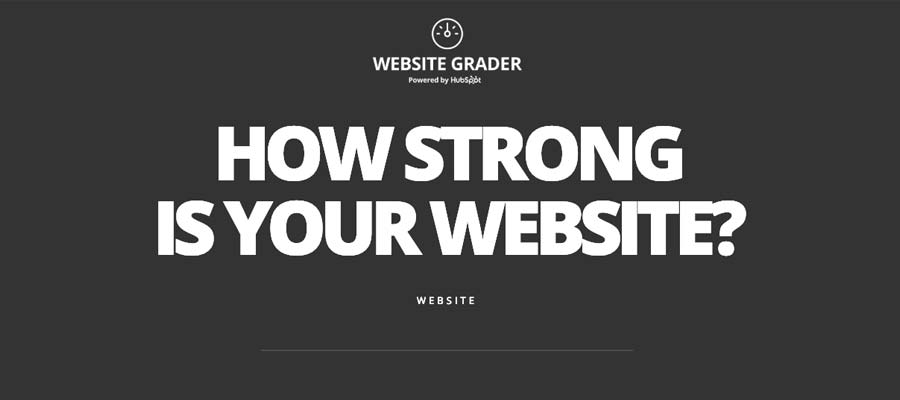
Their website grader tool requires you to sign-up before getting access to the report. Consequently, this helps Hubspot enrich their email marketing database.
This has proven a great tactic. Neil Patel does something similar with his free tool Ubersuggest. He is providing amazing value for free and this makes people come back to his website over and over again.
Back to Hubspot. Hubspot also mastered the art of content marketing. They’ve focused on content related to inbound marketing and this has been driving tremendous traffic to their website.
Their content marketing strategy and free tool offerings helped Hubspot to achieve $1.6 billion market value in 2015, according to their CTO Dharmesh Shah.
2. Dropbox
Dropbox is a company with a bunch of great growth hackers who always come up with creative stuff.
The team at Dropbox gamified its onboarding experience. New users can gain extra storage by completing steps such as inviting friends, connecting to social media, and confirming your email address.
To further onboard users, Dropbox added small tasks so that people take their first steps in using their product. When completing these steps, users would again get extra storage.
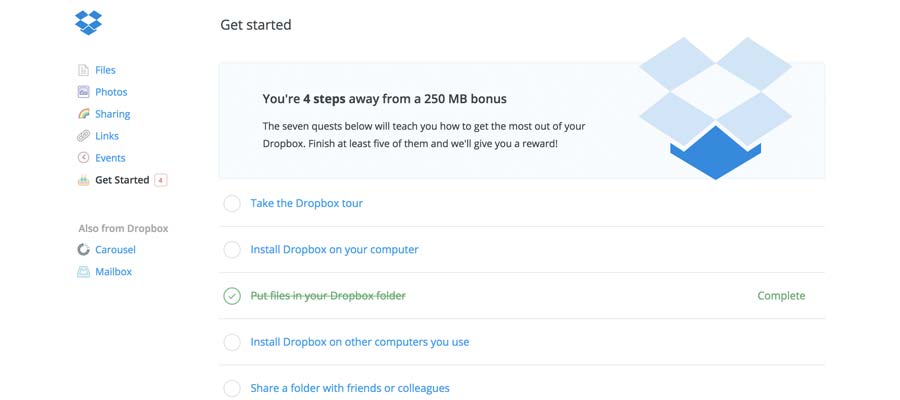
This has worked fantastically as Dropbox now has over 500 million users and annual revenue over a billion dollars.
3. Instagram
Instagram has over one billion users so they know a thing or two about growth hacking. Everyone knows Instagram today, but that wasn’t always the case.
Instagram achieves exponential marketing growth at early stages due to:
- Having a product with features geared towards to needs of its users;
- Having a great onboarding experience and focusing on customer experience;
- They had a brand ambassador program;
- They let people try the product before launch;
- They used influencers to promote the product.
4. LinkedIn
If you have a job, or if you are looking for one, you probably have a LinkedIn account. LinkedIn made it easy for people to collect recommendations and staying in touch with your professional network. Not everyone wants to add their boss on Facebook!
LinkedIn allows you to create your own professional profile. When people search your name on Google, they will most likely see your LinkedIn profile. This caused a tremendous amount of traffic to LinkedIn and was their principal growth hacking technique.
As people saw their profile is being viewed by others, people started spending more time on the platform. If you take a look at the AARRR framework discussed earlier, you quickly realize that LinkedIn perfected every category. They are a master at acquisition due to the search traffic coming from individual name searches.
They’ve activated news users through guiding them and making them reach an “all-star” profile level.
As LinkedIn grew, people started spending more time on the platform, nailing the Retention category of the AARRR framework.
LinkedIn has found a way to monetize the platform by providing more features if you have a paid plan; A stellar revenue model.
And finally, people are always talking about LinkedIn. The platform provides so much value that people just want to talk about it. They’ve nailed referral marketing.
LinkedIn is truly a perfect example case of growth hacking and demand generation.
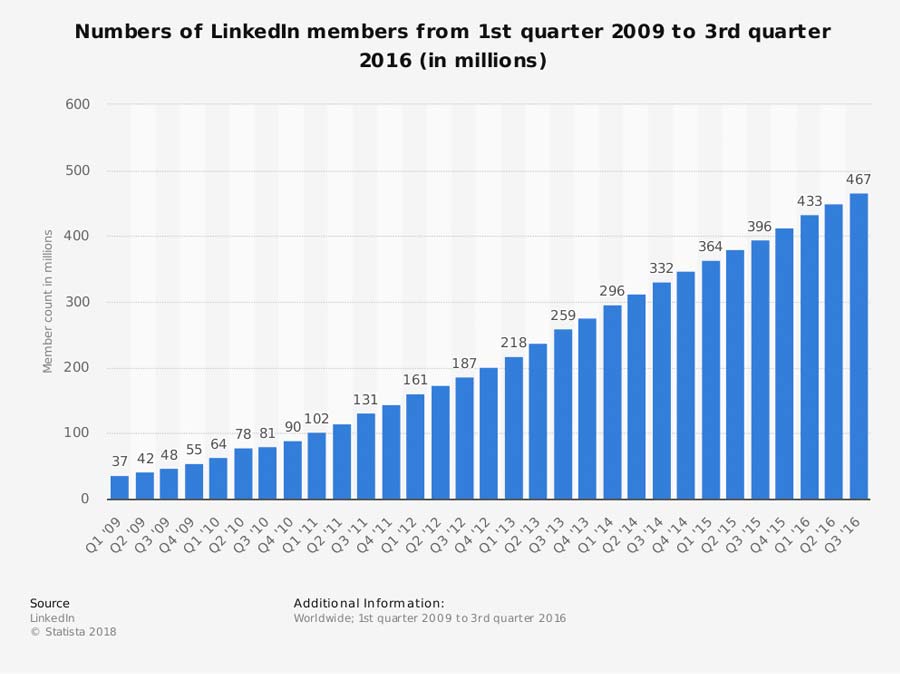
5. Netflix
Ever heard of Netflix before? Yep, so did everyone else.
Of course, Netflix major selling point is that it allows people to watch movies and series whenever they want, without commercials!
Netflix started out in the DVD rental business and used a growth hacking technique to drive demand for its streaming services. Netflix focused on small communities of interest and got in front of those communities on forums and other online platforms. With this strategy, Netflix suddenly went viral and received 100.000 orders within the first three months without real marketing.
Netflix literally disrupted the TV market and tapped into the needs of the customers. It was a risky move, but it paid off. Their main strategy was to directly talk to the customers and get their product in front of them. They’ve since slowly started expanding to other countries and now is a global success.
6. Paypal
Paypal nailed referral marketing and that is how they’ve achieved rapid marketing growth. Paypal had a referral program that incentivized users to recommend Paypal to others. However, this came at a cost. $60 million to be exact.
Paypal realized that word-of-mouth spreads the fastest and when Paypal came up, social media wasn’t a big thing yet. So what did they do? Paypal grew through people recommending them on blogs, instant messaging platforms, and emails.
$60 million sure sounds like a lot, but it a drop in a bucket compared to today’s value of over $100 billion.
This growth is only possible when people are talking about you. To achieve this growth, you can’t do it alone. You need the general public to launch your company into the stratosphere.
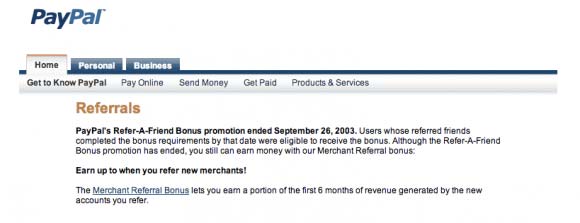
7. Slack
Slack is a newer company that has recently seen tremendous success. It’s one of the fastest-growing B2B SaaS companies.
Slack has realized that email is slowly starting to fade away and that there is a need for more instant messaging. I can’t even describe how much time Slack has saved me, compared to just writing emails all the time.
I’ve got a question for you. Did you feel like you needed a better way to communicate digitally than writing emails? Most of us probably didn’t. However, Slack identified a problem that most people didn’t even know existed. Why? They didn’t know any better.
The problem with email is that it is slow and it can allow for poor communication. Slack took that problem away and relieved stress.
Slack started with a freemium model and allowed people to try the platform out for free. The results?
Slack grew over to 500.000 daily active users in only one year. Today, Slack has over 10 million active daily users!
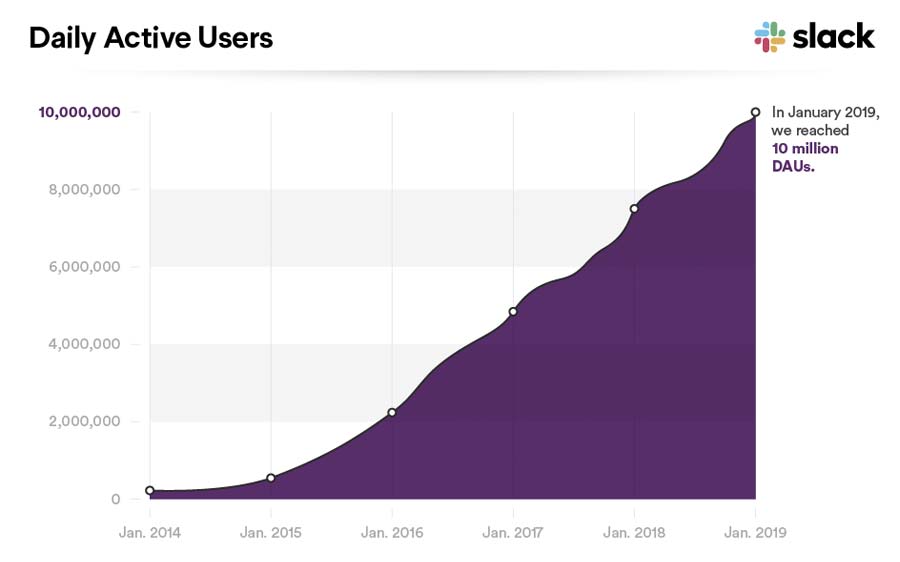
This really illustrates the power of a freemium tool. You need to get people to talk about your product. A freemium tool is a low-barrier way for people to try your product. Consequently, people will start talking about you and your word of mouth advertising is going to increase.
8. Airbnb
The growth hacking Airbnb used to achieve exponential growth is one of my favorites. Nowadays when you need accommodation, you will probably consider Airbnb. But back in the days, this was not the case. They needed to build a user base, a client base and of course a reputation.
The founders of Airbnb realized that many people were looking on Craigslist when looking for alternative accommodation. They saw the huge untapped potential and took massive advantage of it.
Airbnb offered Craiglist users to copy their advertisement to Airbnb with one press of the button. The results were that a huge market started copying their Craigslists advertisements to Airbnb. They started building a reputation and now there are more than 6 million Airbnb listings and 2 million people staying in Airbnb’s every night.

9. Robinhood
Robinhood is a zero-commission stock trading app and used limited availability as a growth hacking technique.
Who doesn’t want to trade stocks with zero commission? Robinhood basically restricted the number of users that can be on the platform. Through this, they’ve created a lot of excitement and a bit of a hype. People were excited when they were finally allowed to use the app and started talking about it. Again, this is a great word-of-mouth.
If you wanted priority access, this was possible. All you had to do is refer to some friends and sharing them on social networks.
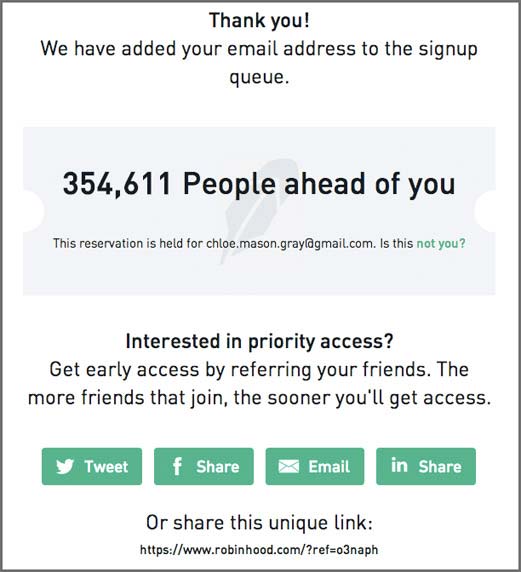
Within one year, Robinhood achieved a waiting list of 1 million people and sparked interest from people around the globe.
10. Reddit
Whenever you search something on the internet, chances are you ended up reading discussions on Reddit.
The founders of Reddit grew the platform by creating loads of fake accounts that were posting content to the platform.
Why? Nobody is going to stay on an inactive platform. So, the founders did it to make people believe the platform was very active and used by loads of people.
When the platform started creating traction, they didn’t have to do it anymore. It was a great growth hacking strategy combined with the fact it was super simple to sign up for the platform. The barrier to entry was low and people started discussions naturally.
In most of these examples, it becomes clear that a low entry barrier is a key growth hacking technique and should be part of any company.
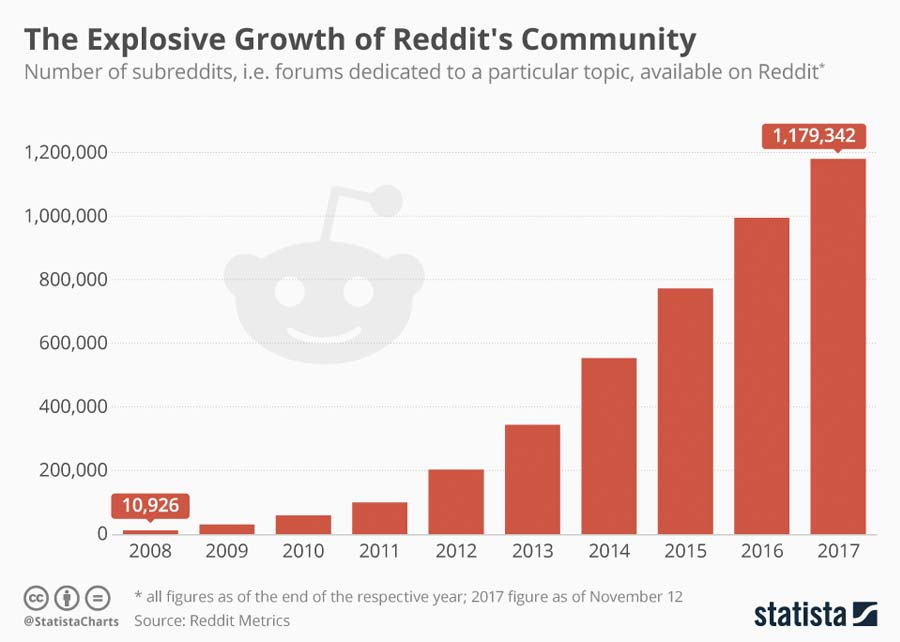
Conclusion
That was a lot of information!
Growth hacking is a process of rapid experimentation across the marketing funnel to grow a business rapidly. The key to successful growth hacking is having the right mindset. Your north star should be growth.
To be a successful growth hacker, you need to have an omnichannel strategy. Focusing on only one thing is not going to get you that exponential marketing growth that you are after.
A great growth hacking framework is the AARRR framework. It stands for Acquisition, Activation, Retention, Revenue, and Referrals. This framework focuses you to look at the entire buyer journey and only then you can send your business out of orbit.
I’ve listed 51 of the best growth hacking tools that I know and 10 stellar examples of companies who achieved it in reality.
I’m interested in how you handle growth hacking.
What strategies did you use to achieve exponential business growth?
Drop me a comment below.

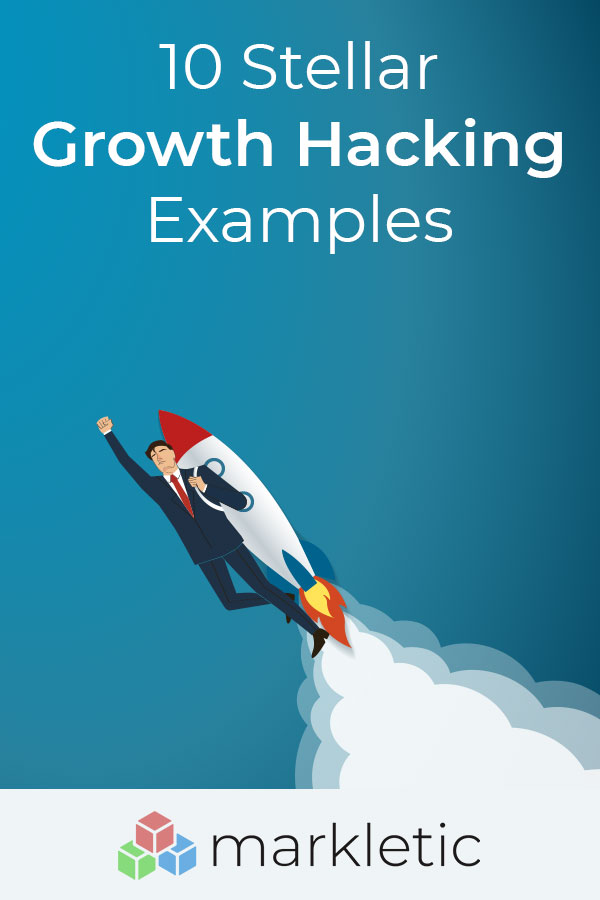
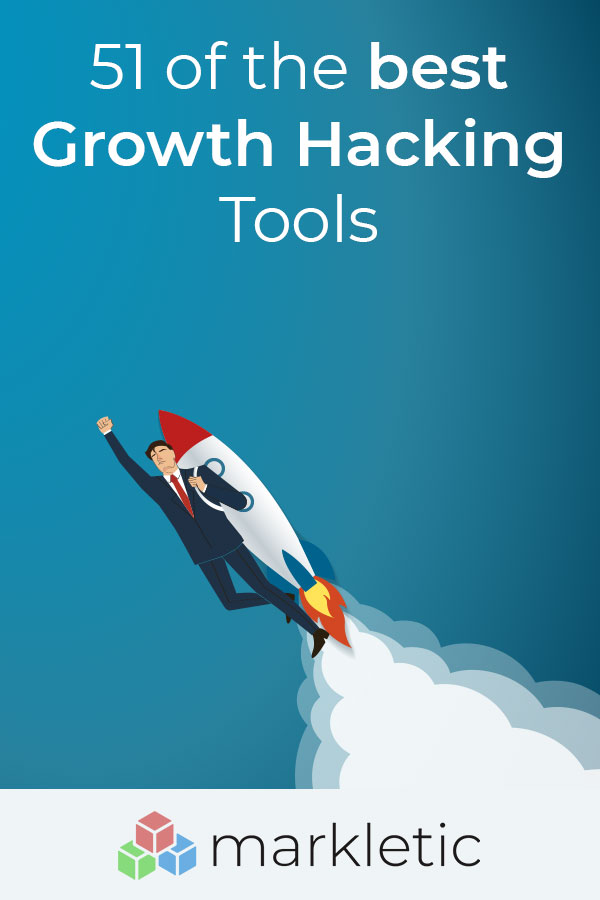
Share this article










Thank you very much for the help and for the effort that you put in to write and share all this amazing content! This was exactly what I was looking for to grow my website.
You're welcome!
oh my God! This is amazing content eish... my website will never be the same again. Thank you so much... I totally appreciate.
I'm glad you liked it! Good luck growth hacking your website!
Hi can you provide more information about growth hacking. Even I am interested in the same.
Hi Oliver, sure thing! Can you be a bit more specific in regards to the information you are seeking?
Happy to help!
Great tips!
Social media have large number of people and its all depend on you how you impress then and make your business successful.